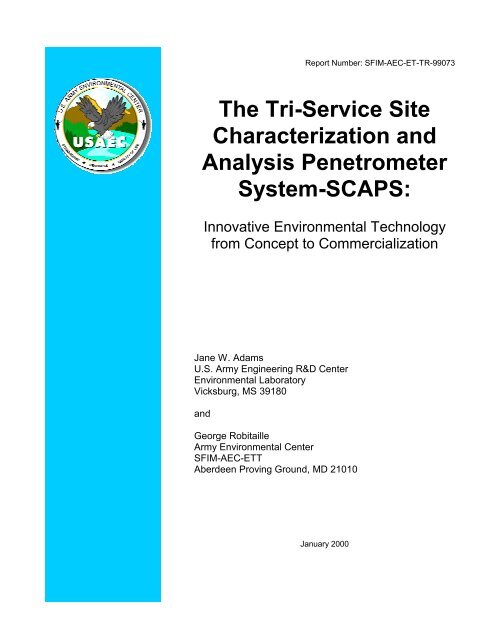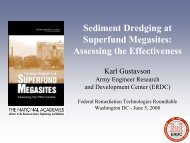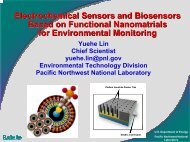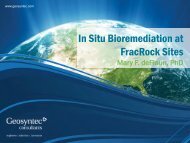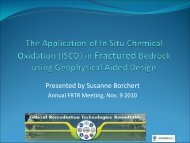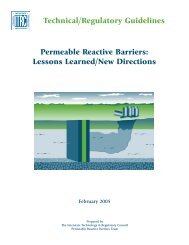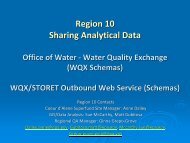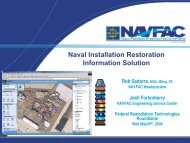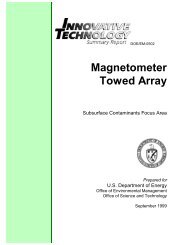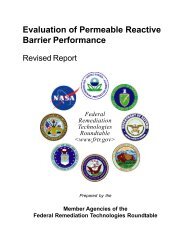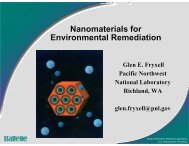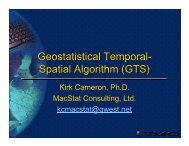The Site Characterization and Analysis Penetrometer ... - CLU-IN
The Site Characterization and Analysis Penetrometer ... - CLU-IN
The Site Characterization and Analysis Penetrometer ... - CLU-IN
You also want an ePaper? Increase the reach of your titles
YUMPU automatically turns print PDFs into web optimized ePapers that Google loves.
Report Number: SFIM-AEC-ET-TR-99073<br />
<strong>The</strong> Tri-Service <strong>Site</strong><br />
<strong>Characterization</strong> <strong>and</strong><br />
<strong>Analysis</strong> <strong>Penetrometer</strong><br />
System-SCAPS:<br />
Innovative Environmental Technology<br />
from Concept to Commercialization<br />
Jane W. Adams<br />
U.S. Army Engineering R&D Center<br />
Environmental Laboratory<br />
Vicksburg, MS 39180<br />
<strong>and</strong><br />
George Robitaille<br />
Army Environmental Center<br />
SFIM-AEC-ETT<br />
Aberdeen Proving Ground, MD 21010<br />
January 2000
THIS PAGE <strong>IN</strong>TENTIALLY LEFT BLANK
REPORT DOCUMENTATION PAGE<br />
Form Approved<br />
OMB No. 0704-0188<br />
<strong>The</strong> public reporting burden f or this collect ion of inf ormat ion is est imated t o average 1 hour per response, including t he time for review ing instructions, searching existing data sources,<br />
gathering <strong>and</strong> maint aining the dat a needed, <strong>and</strong> complet ing <strong>and</strong> review ing t he collection of inf ormation. Send comment s regarding this burden estimate or any other aspect of this collection<br />
of inf ormat ion, including suggest ions f or reducing t he burden, t o Depart ment of Defense, Washington Headquarters Services, Direct orat e f or Informat ion Operat ions <strong>and</strong> Report s<br />
(0704-0188), 1215 Jefferson Davis Highway, Suite 1204, Arlington, VA 22202-4302. Respondents should be aware that notwithst<strong>and</strong>ing any other provision of law, no person shall be<br />
subject to any penalty for failing to comply w ith a collection of information if it does not display a currently valid OMB control number.<br />
PLEASE DO NOT RETURN YOUR FORM TO THE ABOVE ADDRESS.<br />
1. REPORT DATE (DD-MM-YYYY) 2 . REPORT TYPE<br />
01/01/00<br />
Final Report<br />
4. TITLE AND SUBTITLE<br />
<strong>The</strong> Tri-Service <strong>Site</strong> <strong>Characterization</strong> <strong>and</strong> <strong>Analysis</strong> <strong>Penetrometer</strong><br />
System-SCAPS:<br />
Innovative Environmental Technology from Concept to Commercialization<br />
3. DATES COVERED (From - To)<br />
Summary 1987-1999<br />
5a. CONTRACT NUMBER<br />
5b. GRANT NUMBER<br />
5 c. PROGRAM ELEM ENT NUM BER<br />
6. AUTHOR(S)<br />
Jane W. Adams<br />
U.S. Army Engineering R&D Center<br />
<strong>and</strong><br />
George Robitaille<br />
Army Environmental Center<br />
7. PERFORM<strong>IN</strong>G ORGANIZATION NAME(S) AND ADDRESS(ES)<br />
U.S. Army Environmental Center<br />
SFIM-AEC-ETT (George Robitaille)<br />
Bldg 4430<br />
5179 Hoadley Road<br />
Aberdeen Proving Ground, MD 21010-5401<br />
9. SPONSOR<strong>IN</strong>G/MONITOR<strong>IN</strong>G AGENCY NAME(S) AND ADDRESS(ES)<br />
U.S. Army Environmental Center<br />
SFIM-AEC-ETT (George Robitaille)<br />
Bldg 4430<br />
5179 Hoadley Road<br />
Aberdeen Proving Ground, MD 21010-5401<br />
George.Robitaille@aec.apgea.army.mil 410-436-6865<br />
1 2 . DISTRIBUTION/ AVAILABILITY STATEM ENT<br />
Unclassified. Distribution is unlimited. Further information may be found at:<br />
http://aec.army.mil<br />
Requests for information should be addressed to the Project Officer in Block 9<br />
5 d. PROJECT NUM BER<br />
5e. TASK NUMBER<br />
5f. WORK UNIT NUMBER<br />
8. PERFORM<strong>IN</strong>G ORGANIZATION<br />
REPORT NUMBER<br />
SFIM-AEC-ET-TR-99073<br />
10. SPONSOR/MONITOR'S ACRONYM(S)<br />
1 1 . SPONSOR/ M ONITOR' S REPORT<br />
NUMBER(S)<br />
SFIM-AEC-ET-TR-99073<br />
13. SUPPLEMENTARY NOTES<br />
14. ABSTRACT<br />
This report summarizes the conceptualization, development <strong>and</strong> field demonstrations of the <strong>Site</strong> <strong>Characterization</strong> <strong>and</strong> <strong>Analysis</strong><br />
<strong>Penetrometer</strong> System (SCAPS) technology from 1987 to 1999. <strong>The</strong> SCAPS provides reliable in-situ soil <strong>and</strong> groundwater testing<br />
for environmental site characterization. Probes to detect <strong>and</strong> quantify petroleum products, volatile organics, metals, explosives<br />
<strong>and</strong> radionuclides are being used by the Army <strong>and</strong> Navy, <strong>and</strong> are also available for commercial licensing.<br />
15. SUBJECT TERMS<br />
SCAPS, cone penetrometer, site characterization, soil contaminants<br />
16. SECURITY CLASSIFICATION OF:<br />
a. REPORT<br />
U<br />
b. ABSTRACT<br />
U<br />
c. THIS PAGE<br />
U<br />
17. LIMITATION OF<br />
ABSTRACT<br />
U<br />
ii<br />
18. NUMBER<br />
OF<br />
PAGES<br />
40<br />
19a. NAME OF RESPONSIBLE PERSON<br />
George Robitaille<br />
1 9 b. TELEPHONE NUM BER (Include area code)<br />
410-436-6865<br />
St<strong>and</strong>ard Form 298 (Rev. 8/98)<br />
Prescribed by ANSI St d. Z39. 18
THIS PAGE <strong>IN</strong>TENTIALLY LEFT BLANK<br />
iii
TABLE OF CONTENTS<br />
REPORT DOCUMENTATION PAGE …………………………………………… ii<br />
TABLE OF CONTENTS …………………………………………………………… iv<br />
EXECUTIVE SUMMARY …………………………………………………………. vi<br />
I. <strong>IN</strong>TRODUCTION ……………………………………………………………….. 3<br />
II. OVERVIEW OF AVAILABLE SCAPS TECHNOLOGIES<br />
AND SITES ……………………………………………………………………... 5<br />
III. THE SCAPS TRUCK …………………………………………………………. 11<br />
1. Truck <strong>and</strong> Push Platform ………………………………………………….. 11<br />
2. Grouting Capabilities ………………………………………………………. 12<br />
IV. SITE CHARACTERIZATION AND ANALYSIS PROBES ………………… 13<br />
1. Petroleum, Oils <strong>and</strong> Lubricants: <strong>The</strong> Laser Induced<br />
Fluorescence (LIF) Sensor ……………………………………………….. 13<br />
2. Volatile Organic Compounds Sensing Tools …………………………… 14<br />
A. <strong>The</strong>rmal Desorption Sampler (TDS) …………………………………... 14<br />
B. Hydrosparge Sensor ……………………………………………………. 15<br />
C. Vadose Sparge Sensor ………………………………………………… 16<br />
3. Explosives Sensing ………………………………………………………... 17<br />
4. Metals Sensing …………………………………………………………….. 17<br />
A. Laser Induced Breakdown Spectroscopy (LIBS)<br />
Sensors …………………………………………………………………… 17<br />
B. X-Ray Fluorescence (XRF) Sensor …………………………………… 19<br />
5. Radionuclides ………………………………………………………………. 19<br />
A. Spectral Gamma Probe ………………………………………………… 19<br />
B. Multisensor Probe ……………………………………………………….. 20<br />
V. TECHNOLOGY TRANSFER …………………………………………………. 21<br />
1. Points of Contact …………………………………………………………… 21<br />
2. Patents ………………………………………………………………………. 22<br />
3. Licenses …………………………………………………………………….. 22<br />
4. Publications, Presentations <strong>and</strong> Electronic Information ……………….. 22<br />
5. Certification <strong>and</strong> Regulatory Acceptance ………………………………... 23<br />
A. Certifications <strong>and</strong> Evaluations for the Laser-Induced<br />
Fluorescence (LIF) Sensor …………………………………………….. 23<br />
B. Certifications <strong>and</strong> Evaluations for the VOC Sensors ………………… 25<br />
VI. ECONOMIC BENEFITS OF SCAPS ……………………………………….. 27<br />
VII. BIBLIOGRAPHY …………………………………………………………... 29<br />
iv
THIS PAGE <strong>IN</strong>TENTIALLY LEFT BLANK<br />
v
EXECUTIVE SUMMARY<br />
Hazardous waste contamination in soil <strong>and</strong> groundwater poses significant problems<br />
for society, especially in terms of health <strong>and</strong> expense. Before a hazardous site can be<br />
cleaned up, it must first be mapped to determine the extent of subsurface<br />
contamination. Traditional site characterization is performed by collecting samples from<br />
soil boring or monitoring wells <strong>and</strong> then sending them to an off-site laboratory for<br />
analysis. This practice is extremely costly, time consuming <strong>and</strong> prone to error in<br />
determining the direction <strong>and</strong> extent of the contaminant plume. <strong>The</strong> Army recognized<br />
the need for improved, on site characterization tools more than ten years ago <strong>and</strong><br />
began developing a direct-push chemical sensor for petroleum hydrocarbon<br />
contaminant in soil.<br />
<strong>The</strong> Tri-Service <strong>Site</strong> <strong>Characterization</strong> <strong>and</strong> <strong>Analysis</strong> <strong>Penetrometer</strong> System, or<br />
SCAPS, program began in 1987 under sponsorship of the U.S. Army Toxic <strong>and</strong><br />
Hazardous Materials Agency (now the U.S. Army Environmental Center) to address the<br />
need for rapid site characterization of soil contamination at U.S. Army facilities. <strong>The</strong><br />
program evolved into a Tri-Service (Army, Air Force <strong>and</strong> Navy), multi-year research,<br />
development, <strong>and</strong> technology demonstration program with additional funding by the<br />
SERDP <strong>and</strong> ESTCP. <strong>The</strong> U.S. Department of Energy (DOE) <strong>and</strong> U.S. Environmental<br />
Protection Agency (EPA) also participated in the program. <strong>The</strong> U.S. Army<br />
Environmental Center took the lead for SCAPS sensor development efforts among<br />
DoD, DOE <strong>and</strong> EPA <strong>and</strong> coordinated with regulatory agencies, as well as potential<br />
government <strong>and</strong> commercial users. SCAPS consists of a commercial cone<br />
penetrometer unit mounted on the custom-designed bed of a 20-ton truck. <strong>The</strong> truck<br />
houses a mechanical room for the cone penetrometer <strong>and</strong> a data analysis room for<br />
operational <strong>and</strong> diagnostic computers <strong>and</strong> instrumentation. A variety of sensor probes<br />
can be attached to the cone penetrometer to investigate soil geophysical properties, or<br />
that respond to classes of contaminants such as petroleum, solvent products, metals<br />
<strong>and</strong> explosives. SCAPS operators use a 20-ton hydraulic press mounted in the truck to<br />
push the sensors up to 150 feet into the soil. <strong>The</strong> SCAPS systems relay information on<br />
subsurface contaminants to the surface for immediate analysis <strong>and</strong> interpretation. <strong>The</strong><br />
final display products SCAPS provides can range from individual push charts to<br />
cumulative 3-D depictions of the subsurface.<br />
<strong>The</strong> use of SCAPS typically saves approximately 50% of the costs of site<br />
characterization, <strong>and</strong> frequently more. Five different technical st<strong>and</strong>ards, methods or<br />
regulatory guidelines for use of SCAPS chemical sensor <strong>and</strong> sampler probes for site<br />
characterization have been approved. SCAPS probes have been used to characterize<br />
petroleum, volatile organics, explosives <strong>and</strong> metals contaminants in over 200 locations<br />
on Army, Navy, Air Force, Department of Energy (DOE) <strong>and</strong> Environmental Protection<br />
Agency (EPA) sites. <strong>The</strong> Army operates four SCAPS trucks, the Navy operates three<br />
<strong>and</strong> the DOE one truck to characterize sites. <strong>The</strong> commercial sector has acquired<br />
SCAPS technology through licensing agreements <strong>and</strong> is putting it to work in the private<br />
sector worldwide.<br />
Highlights of the program are:<br />
vi
• Eleven patents <strong>and</strong> four patent applications.<br />
• EPA Method 8265.<br />
• SCAPS was evaluated <strong>and</strong> recommended under the EPA Superfund Innovative<br />
Technology Evaluation (SITE) program.<br />
• Eight SCAPS trucks being operated by three federal agencies.<br />
• <strong>The</strong> state of California has certified the LIF technology. Reciprocity with 27 other<br />
states has been achieved through the Interstate Technology Regulatory<br />
Cooperation Workgroup (ITRC).<br />
• ASTM St<strong>and</strong>ard Practice for LIF: D-6187-97.<br />
• Documented savings of $6,031,000 at sixteen sites using SCAPS vs. conventional<br />
characterization methods.<br />
vii
<strong>The</strong> Tri-Service <strong>Site</strong> <strong>Characterization</strong> <strong>and</strong> <strong>Analysis</strong> <strong>Penetrometer</strong> System, or<br />
SCAPS, technology was developed to address the problems of time <strong>and</strong> expense in<br />
hazardous waste site characterization. Three Defense services <strong>and</strong> three other federal<br />
agencies coordinated their research <strong>and</strong> development efforts to make this possible.<br />
SCAPS sensor developments <strong>and</strong> demonstrations were funded by the Army<br />
Environmental Center (AEC), the Strategic Environmental Research <strong>and</strong> Development<br />
Program (SERDP) <strong>and</strong> the Environmental Security Technology Certification Program<br />
(ESTCP). It has proven to be an effective tool for rapid site characterization <strong>and</strong><br />
assessment.<br />
SCAPS combines traditional cone penetrometer technology with contaminant<br />
sensors <strong>and</strong> samplers to provide rapid, on-site, cost effective evaluation of soil<br />
contaminants, geophysical properties <strong>and</strong> to direct traditional soil sampling <strong>and</strong> well<br />
placement. Sensors were field tested during development, <strong>and</strong> later demonstrated as<br />
part of several methodology validation programs to gain state <strong>and</strong> federal regulatory<br />
approval. Five different technical st<strong>and</strong>ards, methods or regulatory guidelines resulted<br />
from this effort. SCAPS probes have been used to characterize petroleum, volatile<br />
organics, explosives <strong>and</strong> metals contaminants in over 200 locations on Army, Navy, Air<br />
Force, Department of Energy (DOE) <strong>and</strong> Environmental Protection Agency (EPA) sites.<br />
<strong>The</strong> Army operates four SCAPS trucks, the Navy operates three <strong>and</strong> the DOE one truck<br />
to characterize sites. <strong>The</strong> commercial sector has acquired SCAPS technology through<br />
licensing agreements.<br />
1
This Page Intentionally Left Blank<br />
2
I. <strong>IN</strong>TRODUCTION<br />
Hazardous waste contamination in soil <strong>and</strong> groundwater poses significant problems<br />
for society, especially in terms of health <strong>and</strong> expense. Before a hazardous site can be<br />
cleaned up, it must first be mapped to determine the extent of subsurface<br />
contamination. Traditional site characterization is performed by collecting samples from<br />
soil boring or monitoring wells <strong>and</strong> then sending them to an off-site laboratory for<br />
analysis. <strong>The</strong>se practices are extremely costly, time consuming <strong>and</strong> prone to error in<br />
determining the direction <strong>and</strong> extent of the contaminant plume. <strong>The</strong> Army recognized<br />
the need for improved, on site characterization tools more than ten years ago <strong>and</strong><br />
began developing a direct-push chemical sensor for petroleum hydrocarbons in soil.<br />
This resulted in an active multi-agency effort to develop sensors for other classes of<br />
contaminants, including solvents, metals explosives <strong>and</strong> radioactive wastes. <strong>The</strong><br />
resulting SCAPS chemical sensor innovations to cone penetrometer technology have<br />
made reliable in-situ soil testing for environmental site characterization possible. This<br />
report summarizes the development, field demonstration <strong>and</strong> regulatory acceptance<br />
activities associated with the SCAPS technologies that are used to detect, identify <strong>and</strong><br />
quantify subsurface contamination in soil <strong>and</strong> groundwater.<br />
SCAPS consists of a cone penetrometer unit mounted on the custom-designed bed<br />
of a 20-ton truck. A variety of sensor probes can be attached to investigate soil<br />
geophysical properties, or that respond to classes of contaminants such as petroleum,<br />
solvent products, metals <strong>and</strong> explosives. SCAPS operators use a 20-ton hydraulic<br />
press mounted in the truck to push the sensors up to 150 feet into the soil. <strong>The</strong> SCAPS<br />
systems relay information on subsurface contaminants to the surface for immediate<br />
analysis <strong>and</strong> interpretation.<br />
SCAPS can collect <strong>and</strong> analyze field data faster than traditional methods because<br />
the need for drilling to collect soil for remote laboratory analyses can be reduced, <strong>and</strong> in<br />
some cases, avoided. SCAPS costs about 50% less than conventional drilling <strong>and</strong><br />
sampling, so researchers can collect more samples in a shorter time <strong>and</strong> quickly define<br />
a site’s contamination boundaries. Because SCAPS is mobile, data can be also be<br />
gathered from areas inaccessible to drill rigs. In fact, much of the cone penetrometer<br />
data collected in real-time can be used for on-site decision making by the site<br />
investigators, as well as regulatory officials. SCAPS produces less investigationderived<br />
waste than traditional site-characterization tools. SCAPS also can delineate the<br />
extent of subsurface contamination more accurately <strong>and</strong> for less money than widely<br />
spaced monitoring wells.<br />
<strong>The</strong> SCAPS program began in 1987 under sponsorship of the U.S. Army Toxic <strong>and</strong><br />
Hazardous Materials Agency (now the U.S. Army Environmental Center) to address the<br />
need for rapid site characterization of soil contamination at U.S. Army facilities. <strong>The</strong><br />
program evolved into a Tri-Service (Army, Air Force <strong>and</strong> Navy), multi-year research,<br />
development, <strong>and</strong> technology demonstration program with additional funding by the<br />
SERDP <strong>and</strong> ESTCP. <strong>The</strong> U.S. Department of Energy (DOE) <strong>and</strong> U.S. Environmental<br />
Protection Agency (EPA) also participated in the program. <strong>The</strong> U.S. Army<br />
3
Environmental Center took the lead for SCAPS sensor development efforts among<br />
DoD, DOE <strong>and</strong> EPA <strong>and</strong> coordinated with regulatory agencies, as well as potential<br />
government <strong>and</strong> commercial users. Some highlights of the program are:<br />
• Eleven patents <strong>and</strong> four patent applications.<br />
• EPA Method 8265.<br />
• SCAPS was evaluated <strong>and</strong> recommended under the EPA Superfund Innovative<br />
Technology Evaluation (SITE) program.<br />
• Eight SCAPS trucks being operated by three federal agencies.<br />
• <strong>The</strong> state of California has certified the LIF technology. Reciprocity with 27 other<br />
states has been achieved through the Interstate Technology Regulatory<br />
Cooperation Workgroup (ITRC).<br />
• ASTM St<strong>and</strong>ard Practice for LIF: D-6187-97.<br />
• Documented savings of $6,031,000 at sixteen sites using SCAPS vs.<br />
conventional characterization methods.<br />
4
II. OVERVIEW OF AVAILABLE SCAPS TECHNOLOGIES AND SITES<br />
<strong>The</strong> SCAPS is a component-based system of sensors that are used<br />
interchangeably with the SCAPS truck platform. No special permits are required for the<br />
operation of a cone penetrometer. Regulatory approval is typically h<strong>and</strong>led as in<br />
st<strong>and</strong>ard drilling, where a drilling plan is submitted to the appropriate regulatory agency<br />
for their approval prior to initiation of work. Table 1 describes the parts of the SCAPS<br />
system briefly. More details concerning specific probes follows in Section III, <strong>The</strong><br />
SCAPS Equipment.<br />
TABLE 1. OPERAT<strong>IN</strong>G COMPONENTS OF THE SCAPS<br />
SCAPS Truck<br />
Data acquisition compartment <strong>and</strong> push room compartment (rod<br />
storage <strong>and</strong> hydraulic push ram) are isolated <strong>and</strong> have air quality<br />
monitors. Rods are steam cleaned before they enter the push<br />
compartment to keep hazardous materials from entering the vehicle.<br />
Grouting Capability Grout is used to seal the penetration hole when a push is<br />
completed. A cement <strong>and</strong> water mixture is pumped through<br />
a tube in the penetrometer to fill the hole as the push rods<br />
are brought to the surface. This eliminates the potential<br />
movement of contamination from one soil layer to another.<br />
Geotechnical Probes<br />
Soil Sampler Commercial probes to retrieve soil samples from discrete<br />
subsurface locations for further analysis<br />
Geotechnical Sensor<br />
Moisture Probe<br />
Pore Pressure Probe<br />
Liquid/Gas Sampler<br />
Small Diameter Well Installation<br />
Measures geotechnical properties to determine soil types<br />
(according to ASTM-D-3441-86), that can aid in well<br />
construction <strong>and</strong> remediation system design. NOTE:<br />
Attached to tip of other sensor probes<br />
Quantifies soil moisture content <strong>and</strong> can aid in calculating<br />
hydraulic conductivity.<br />
Quantifies soil pore pressure for site hydraulic studies, such<br />
as direction <strong>and</strong> rate of groundwater flow <strong>and</strong> provides<br />
discrete values of relative hydraulic conductivity.<br />
Extracts liquid or gas samples from the subsurface for further<br />
analysis<br />
Installs commercial, custom designed wells using direct push<br />
technology for access to groundwater.<br />
Contaminant Probes<br />
Hydrocarbon Sensor System Detects hydrocarbon contaminated soil real-time using solid<br />
state, laser induced fluorescence(LIF) technology. <strong>The</strong> LIF<br />
process has been accepted by US EPA, California EPA, <strong>and</strong><br />
many state <strong>and</strong> local agencies.<br />
Direct Sampling Ion Trap Mass<br />
Spectrometer (DS-ITMS)<br />
VOCS are collected using several SCAPS sampling probes,<br />
which extract gases from the sample matrix <strong>and</strong> transport<br />
5
Hydrosparge/ITMS VOC Sensor<br />
<strong>The</strong>rmal Desorption Sampler<br />
Vadose Sparge/ITMS Sensor<br />
Explosives Sensor<br />
Laser Induced Breakdown<br />
Spectroscopy (LIBS)<br />
X-ray Fluorescence (XRF)<br />
Spectral Gamma<br />
them through an appropriate transfer line into a direct<br />
capillary restrictor interface to the ion trap. Targeted<br />
compounds may be identified based on unique peaks in the<br />
electron impact <strong>and</strong> proton transfer chemical ionization mass<br />
spectra. Sample analysis takes 2 to 3 minutes. Using EPA<br />
method 8265 (conditional), the ITMS is capable of detecting<br />
most VOCs qualitatively <strong>and</strong> quantitatively in the low part per<br />
billion (ppb) range.<br />
<strong>The</strong> Hydrosparge sampler removes gaseous volatiles from<br />
water in a temporary well for real-time analysis by an ion trap<br />
mass spectrometer A commercially available direct push<br />
groundwater sampler is used to make a temporary well.<br />
Groundwater enters <strong>and</strong> is allowed to come to equilibrium.<br />
<strong>The</strong>n the in situ sparge module is lowered into the well to<br />
purge VOC analytes from the groundwater using Helium gas.<br />
<strong>The</strong> probe collects a soil plug into a chamber where the soil is<br />
heated. A pneumatic system transports purged VOC compounds to<br />
the surface for analysis by an ITMS, or are collected onto traps for<br />
later analysis.<br />
Measurements are made during probe retraction. A sacrificial<br />
sleeve is used to protect the sampling ports during the penetrometer<br />
push to the depth of interest, whereupon soil friction removes the<br />
sleeve when the probe is retracted. This creates a gap between the<br />
probe <strong>and</strong> the soil. A pneumatic system transports a carrier gas<br />
down through the probe where it is swept past the soil surface<br />
before the resultant vapors are drawn up to the ITMS in the truck.<br />
This probe uses electrochemical sensors that detect the<br />
presence of NO x chemical compounds that are released by<br />
explosives. <strong>The</strong> NO x sensors in the probe show a change in<br />
current that is proportional to the amount of explosive<br />
chemicals in the soil.<br />
<strong>The</strong> LIBS Sensor system focuses a high-power pulsed laser onto the<br />
surface of the soil to generate diagnostic plasma. Specific<br />
wavelengths of the light in the plasma correspond to specific metal<br />
elements present in the soil. <strong>The</strong> brightness of the light at a given<br />
wavelength indicates how much of that metal is present. LIBS can<br />
detect metals in the single ppm range.<br />
Uses an electron tube to excite metal atoms in the soil. <strong>The</strong><br />
XRF sensor detects the characteristic x-rays the metal atoms<br />
emit.<br />
<strong>The</strong> probe uses a NaI scintillation crystal to detect gamma<br />
radiation from radioactive waste directly in the ground. <strong>The</strong><br />
spectral gamma results are analyzed to diagnose radionuclide<br />
identity <strong>and</strong> relative concentration.<br />
6
Video Microscope System<br />
Provides real-time video images of the subsurface. 100X<br />
magnification provides soil type information <strong>and</strong> displays<br />
DNAPL contaminants. <strong>The</strong> GeoVIS system, developed by the<br />
Navy, uses a miniature video camera coupled with<br />
magnification <strong>and</strong> focusing lens systems integrated into a<br />
cone penetrometer probe to obtain images of soil. <strong>The</strong> signal<br />
from the camera is sent to the surface where it can be viewed<br />
in real-time on a video monitor, recorded <strong>and</strong>/or digitized for<br />
further analysis. Objects as small as about 20 microns can<br />
be resolved. <strong>The</strong> present optics system provides<br />
approximately a 100x magnification factor when viewed on<br />
the st<strong>and</strong>ard 13-inch monitor.<br />
Use of SCAPS probes can potentially save from 25% to more than 50% of<br />
traditional site characterization costs. Trucks are currently being operated on a fee<br />
basis by three Army Corps of Engineer Districts: Kansas City, Savannah <strong>and</strong> Tulsa.<br />
<strong>The</strong> Navy operates three trucks through their Public Works Centers, two based on the<br />
West Coast in San Diego, CA <strong>and</strong> one on the East Coast at Norfolk, VA. In addition,<br />
the Navy <strong>and</strong> the Army Corps of Engineers each maintain fully equipped research<br />
SCAPS vehicles. <strong>The</strong> Department of Energy owns one truck that is operated for the<br />
DOE at their sites by commercial contractors.<br />
<strong>The</strong> primary goal of SCAPS site demonstrations is to show the efficiency <strong>and</strong><br />
accuracy of SCAPS sensors <strong>and</strong> samplers. Another very important objective has been<br />
to facilitate technology transfer by partnering with other Tri-Service users <strong>and</strong> with<br />
project managers who are interested in using innovative methods to characterize their<br />
sites. <strong>The</strong> U.S. Army Engineer SCAPS Districts, the Navy SCAPS, the DOE <strong>and</strong><br />
various site manager personnel have participated in the demonstration <strong>and</strong> use of new<br />
probes.<br />
Table 2 presents a list of the sites at which SCAPS probes were demonstrated<br />
during the development programs. Table 3 lists facilities that have contracted for<br />
SCAPS probes to perform site characterization work. Papers <strong>and</strong> reports that<br />
summarize several of the site investigations may be found in Section VII, Bibliography.<br />
7
TABLE 2. LIST OF SITE LOCATIONS USED FOR SCAPS DEMONSTRATION OF<br />
DEVELOPMENTAL PROBES<br />
LIF POL Sensor<br />
Hydrosparge Sensor,<br />
RCl/VOC<br />
Electrochemical Sensor<br />
<strong>and</strong> <strong>The</strong>rmal Desorption<br />
Sampler<br />
Explosives Sensor<br />
Laser Induced<br />
Breakdown<br />
Spectroscopy Sensors<br />
X-ray Fluorescence<br />
Sensor<br />
DOE Pantex, Texas<br />
Sierra Army Depot, California<br />
Fort Dix, New Jersey<br />
Jacksonville Naval Air Station, Florida<br />
Philadelphia Naval Shipyard, Pennsylvania,<br />
DOE Savannah River <strong>Site</strong>, South Carolina<br />
Building 4020 <strong>Site</strong>, Aberdeen Proving Ground, Maryl<strong>and</strong><br />
Walnut Creek Watershed, Ames, Iowa<br />
Gr<strong>and</strong>ville, Michigan Superfund <strong>Site</strong><br />
Rhein Main Air Base, Germany<br />
Aberdeen Proving Ground (APG), Maryl<strong>and</strong>:<br />
Building 525<br />
Bush River Area<br />
U.S. Army Cold Regions Research <strong>and</strong> Engineering<br />
Laboratory (CRREL), New Hampshire<br />
McClellan Air Force Base, California<br />
Vance Air Force Base, Oklahoma (Hydrosparge only)<br />
Yuma Proving Ground, Arizona (Hydrosparge only)<br />
Ft. Dix, New Jersey<br />
North Isl<strong>and</strong> Naval Air Station, California<br />
Longhorn Army Ammunition Plant, Texas<br />
Joliet Army Ammunition Plant, Illinois (TDS only)<br />
Lake City Army Ammunition Plant, Missouri (TDS only)<br />
Volunteer Army Ammunition Plant, Tennessee<br />
Longhorn Army Ammunition Plant, Texas<br />
Joliet Army Ammunition Plant, Illinois<br />
DOE Pantex, Texas<br />
Keesler Air Force Base, Mississippi<br />
Joliet Army Ammunition Plant, Illinois<br />
Lake City Army Ammunition Plant, Missouri<br />
North Isl<strong>and</strong> Naval Air Station, California<br />
Waterways Experiment Station, Mississippi<br />
J-Field, Edgewood Area, Aberdeen Proving Ground,<br />
Maryl<strong>and</strong><br />
Joliet Army Ammunition Plant, Illinois (2x)<br />
Lake City Army Ammunition Plant, Missouri<br />
North Isl<strong>and</strong> Naval Air Station, California<br />
8
TABLE 3. CONTRACTED SCAPS SITE CHARACTERIZATION WORK LOCATIONS<br />
LIF POL Sensor<br />
Hydrosparge Sensor<br />
Spectral Gamma Sensor<br />
XRF Metals Sensor<br />
Camp Pendleton, CA<br />
FISC Fuel Farm, Point Loma, CA<br />
Fort Campbell Army Airfield, KY<br />
Fort Dix, NJ<br />
Long Beach Naval Complex, CA<br />
Fort Meade, MD<br />
Former Turner Air Force Base, GA<br />
Travis Air Force Base, CA<br />
Naval Exchange Service Station, San Diego, CA<br />
Norfolk Naval Shipyard, VA<br />
Naval Construction Batallion Center, Port Hueneme, CA<br />
Naval/Marine Corps Reserve Center UST, San Jose, CA<br />
Jacksonville Naval Air Station, FL<br />
Philadelphia Naval Shipyard, PA<br />
Former Donaldson Air Force Base, SC<br />
McClellan Air Force Base, CA<br />
Massachusetts Military Reservation, MA<br />
Vance Air Force Base, OK<br />
Yuma Proving Ground, AZ<br />
Ft. Dix, NJ<br />
North Isl<strong>and</strong> Naval Air Station, CA<br />
Lake City Army Ammunition Plant, MO<br />
Whiting Field Naval Air Station, FL<br />
DOE Savannah River <strong>Site</strong>, SC<br />
Travis Air Force Base, CA<br />
9
This Page Intentionally Left Blank<br />
10
III. THE SCAPS TRUCK<br />
1. Truck <strong>and</strong> Push Platform<br />
<strong>The</strong> core of SCAPS is a 20-ton truck-mounted cone penetrometer platform that is<br />
used to deploy chemical <strong>and</strong> physical sensors, <strong>and</strong> soil or water samplers (See Figure<br />
1). SCAPS may also be used to install small, direct push monitoring wells. Hydraulic<br />
lift rams at the front <strong>and</strong> rear of the truck are used to level the truck over the push<br />
location. <strong>The</strong> truck bed supports two separate, enclosed work compartments that are<br />
monitored for air quality <strong>and</strong> temperature. <strong>The</strong> “push room” contains rods threaded with<br />
umbilical cable <strong>and</strong> a vertical hydraulic ram that forces the cone penetrometer into the<br />
ground at a controlled rate. <strong>The</strong> st<strong>and</strong>ard speed is 2 cms -1 . In nominally consolidated<br />
soil, a probe can be pushed to a depth of 50 m below the ground surface. It is st<strong>and</strong>ard<br />
procedure to collect <strong>and</strong> record data every 2 cm, although some probes may be<br />
operated continuously.<br />
A pressure steam cleaner is fixed outside the truck below the push room. Rods are<br />
cleaned as they are retracted, producing a minimal amount of decontamination water at<br />
each site. This means there is significant reduction of investigation-derived wastes<br />
from SCAPS as compared to conventional drilling <strong>and</strong> sampling operations.<br />
<strong>The</strong> SCAPS data acquisition room contains real-time data acquisition, processing<br />
<strong>and</strong> storage computers. It also provides bench space for a spectrometer or other<br />
peripheral equipment, an universal power supply (UPS), <strong>and</strong> a post-processing<br />
computer system for 3-dimensional visualization of subsurface soil stratigraphy <strong>and</strong><br />
contaminant plumes.<br />
Figure 1. <strong>The</strong> SCAPS truck <strong>and</strong> grout trailer. <strong>The</strong> push room is adjacent to the cab <strong>and</strong><br />
the data room is at the rear. This shows the truck leveled by the hydraulic rams at the<br />
front <strong>and</strong> rear of the truck.<br />
11
2. Grouting Capabilities<br />
<strong>The</strong> SCAPS penetrometer leaves a very narrow hole in the ground after the<br />
sensors/samplers are removed from the push location. Although it is small (diameter <<br />
2 in.), it is an avenue for cross contamination of subsurface layers <strong>and</strong> groundwater<br />
aquifers. It is a st<strong>and</strong>ard to seal penetrometer holes at the end of a push to minimize<br />
the potential for migration of contaminants. Grout is injected into the hole through the<br />
probe tip as the probe is pulled from the ground. As the penetrometer rods are brought<br />
up to the surface, a mixture of Portl<strong>and</strong> cement, bentonite clay, <strong>and</strong> water is pumped<br />
through an internal tube down to the bottom rod. <strong>The</strong> pressure of the liquid blows an<br />
expendable tip off the tip of the probe, <strong>and</strong> the grout flows into the cavity, sealing the<br />
hole. Open holes may also be filled with grout poured from the surface.<br />
12
IV. SITE CHARACTERIZATION AND ANALYSIS PROBES<br />
SCAPS probes usually incorporate geophysical sensors (tip resistance <strong>and</strong> sleeve<br />
friction sensors) for determining soil classifications/layering. <strong>The</strong> probe collects soil<br />
classification versus depth <strong>and</strong> contaminant concentration versus depth information<br />
while the sensor gathers contaminant data. Soil classification is displayed continuously<br />
during a push.<br />
1. Petroleum, Oils <strong>and</strong> Lubricants: <strong>The</strong> Laser Induced Fluorescence (LIF) Sensor<br />
<strong>The</strong> Tri-Service SCAPS LIF Sensor can delineate the extent of subsurface<br />
petroleum, oils, <strong>and</strong> lubricants (POL) contamination, as well as map subsurface<br />
stratigraphy, more accurately <strong>and</strong> less expensively than widely spaced monitoring wells<br />
<strong>and</strong> soil borings. <strong>The</strong> LIF Sensor uses an ultra-violet laser to induce fluorescence in<br />
subsurface POL contamination (See Figure 2). Using a fiber optic cable, the UV-laser<br />
energy is transmitted from the surface down an umbilical, through a sapphire window<br />
located on the side of the probe, <strong>and</strong> is emitted into the surrounding soil. <strong>The</strong> POL<br />
contaminants become excited <strong>and</strong> emit fluorescent energy that is carried by another<br />
fiber optic cable back up to the truck where it is analyzed in real time. This process is<br />
continuous, gathering data as the probe is steadily pushed through the subsurface<br />
media.<br />
<strong>The</strong> SCAPS LIF has obtained numerous evaluations <strong>and</strong> certifications through<br />
state <strong>and</strong> federal regulatory agencies, including the U.S. Environmental Protection<br />
Agency (USEPA) Superfund Innovative Technology Evaluation (SITE) Program, the<br />
EPA Consortium for <strong>Site</strong> <strong>Characterization</strong> Technology (CSCT), the California EPA<br />
Innovative Environmental Technology Certification Program, <strong>and</strong> the Interstate<br />
Technology Regulatory Cooperation (ITRC) Workgroup. A cost/benefit analysis<br />
conducted by DOE (DOE report no. LA-UR-91-4016) indicates that at least 25 to 35<br />
percent cost avoidance can be realized with the SCAPS LIF technology, although<br />
recent practices have generated savings in excess of 50%. <strong>The</strong> patented Tri-Service<br />
SCAPS LIF Sensor is licensed, commercially available, <strong>and</strong> is used worldwide.<br />
13
Figure 2. Schematic of the LIF sampler.<br />
2. Volatile Organic Compounds Sensing Tools<br />
<strong>The</strong> basis for the very successful application of SCAPS probes for sensing Volatile<br />
Organic Compounds (VOCs) in soils is due to the use of Direct Sampling Ion Trap Mass<br />
Spectrometry (DSITMS). <strong>The</strong>se probes work by bringing a sample of gas from soil or<br />
groundwater through a transport line to the DSITMS for analysis in the truck. Sample<br />
analysis takes 2 to 3 minutes <strong>and</strong> detection limits are typically in the range of 1 ppb or<br />
less. <strong>The</strong> ITMS field methodolgy (Method 8265) has been conditionally approved by<br />
the EPA.<br />
A. <strong>The</strong>rmal Desorption Sampler (TDS)<br />
<strong>The</strong> operation of the <strong>The</strong>rmal Desorp-tion VOC Sampler is based on the capture of<br />
a known volume of soil (See Figure 3). <strong>The</strong> TDS is pushed to the desired ground depth<br />
<strong>and</strong> an interior rod retracts the penetrometer tip. <strong>The</strong> probe is then pushed further into<br />
the soil, collecting a 5 gm soil plug in the sample chamber. <strong>The</strong> soil plug is heated,<br />
releasing the VOC gases from the soil. <strong>The</strong> vapors are drawn to the surface by an inert<br />
carrier gas, where they are trapped on an adsorbent media. <strong>The</strong> trap is then thermally<br />
desorbed into an onboard, field portable ITMS where the contaminants are analyzed in<br />
near-real time.<br />
<strong>The</strong> soil plug is then expelled from the sample chamber. <strong>The</strong> sample chamber is<br />
heated <strong>and</strong> purged to remove any residual contamination before the process is<br />
repeated at multiple depths during a single push. Upon completion of the push, grout is<br />
used to seal the penetrometer hole upon retraction.<br />
14
Push to depth<br />
Chamber open to<br />
receive soil<br />
B. Hydrosparge Sensor<br />
Eject soil plug after heating<br />
Figure 3. Schematic of the TDS sampler.<br />
<strong>The</strong> Hydrosparge VOC Sensor uses a commercially available Hydropunch TM or<br />
Powerpunch TM direct push groundwater sampling tool to access the groundwater. <strong>The</strong><br />
Hydropunch TM sampler is pushed to the desired depth <strong>and</strong> the push pipes are retracted,<br />
exposing the screen to the groundwater. <strong>The</strong> water level is then allowed to come to<br />
equilibrium, which generally takes less than 15 to 20 minutes.<br />
<strong>The</strong> in situ sparge module (See Figure 4), developed by Oak Ridge National<br />
Laboratory, is then lowered into the well to operates about 18 inches below the surface.<br />
<strong>The</strong> sparge module purges the VOC analytes in situ from the groundwater using Helium<br />
gas. <strong>The</strong> volatiles sparged out of the water are transported to an ITMS in the truck,<br />
where the contaminants are analyzed in real-time. When the in situ sparge module is<br />
interfaced with a mass flow meter, data may be acquired at various depths, ultimately<br />
producing a depth profile of the contaminant(s).<br />
15
<strong>The</strong> reliability of in situ, direct sparging of VOC analytes from groundwater in<br />
concert with the ITMS has been successfully demonstrated at numerous sites where it<br />
has provided cost savings of at least 40% over conventional methods. <strong>The</strong> technology<br />
is currently being evaluated by the California Environmental Protection Agency<br />
Innovative Environmental Technology Certification Program <strong>and</strong> the U.S. EPA Office of<br />
Hazardous Waste.<br />
Probe<br />
housing<br />
VOCs out to<br />
ITMS in<br />
truck<br />
St<strong>and</strong>ing<br />
groundwater<br />
Water inlet<br />
Hydrosparge screen<br />
C. Vadose Sparge Sensor<br />
Figure 4. Schematic of the in situ sparge module.<br />
<strong>The</strong> SCAPS vadose sparge sensor is a soil vapor probe that is deployed in<br />
conjunction with a DSITMS in the truck. This probe evolved from a probe that was<br />
designed for detecting chlorinated solvents by an electrochemical cell after the<br />
manufacturer of the cell discontinued its production.<br />
<strong>The</strong> Vadose Sparge Sensor consists of a st<strong>and</strong>ard geophysical cone module <strong>and</strong> a<br />
sacrificial sleeve that protects vapor delivery <strong>and</strong> sampling port openings in the probe<br />
during a downward push. Data are taken during probe retraction. <strong>The</strong> sleeve falls off<br />
when the probe is pulled from the ground. A pumping system pushes air from the<br />
surface to ports at the bottom of the sampling module, <strong>and</strong> then outward from the<br />
probe. <strong>The</strong> air sweeps over a cylindrical soil surface area around the probe that<br />
corresponds to an area ~4 in. long by 1.75 in diameter. Soil vapors are transferred to<br />
the purge gas <strong>and</strong> then captured by four intake valves. Vapors are delivered through<br />
the purge-gas tubing to an in situ sparge inlet for input to a DS-ITMS. In situ soil vapor<br />
measurements made with this sensor correlate well with contaminant concentrations of<br />
conventional soil samples measured by gas chromatography/mass spectrometry.<br />
16
3. Explosives Sensing<br />
<strong>Site</strong> characterization of explosives-contaminated sites is frequently difficult, with<br />
physical sampling very costly since the distribution of these contaminants can be<br />
extremely heterogeneous. Cone penetrometry offers cost relief <strong>and</strong> time savings. <strong>The</strong><br />
SCAPS Explosives Sensor was designed to contain electrochemical sensors for<br />
nitroaromatic breakdown products <strong>and</strong> geophysical sensors for determining soil<br />
layering. <strong>The</strong> increase in current output of the sensor electrode is directly related to the<br />
concentration of the explosive in the soil. <strong>The</strong> design uses an imbedded heating<br />
element that is isolated from direct contact with the soil. When the soil is warmed<br />
briefly, explosive compounds vaporize <strong>and</strong> decompose into nitrogen-containing<br />
gaseous products. <strong>The</strong>n the evolved gases are drawn by a pneumatic system through<br />
an internal vapor sweep gas stream into the probe, <strong>and</strong> detected using an NO sensor in<br />
concert with a CO sensor. This duo permits discrimination of explosive organic nitrogen<br />
compounds from inorganic nitrogen compounds such as fertilizers.<br />
<strong>The</strong> safety of this probe was evaluated by an independent contractor. GES<br />
Allegany Ballistics Laboratory SCAPS Explosives Hazard <strong>Analysis</strong> report concludes that<br />
“SCAPS Explosives probe operation offers occasional marginal or remote marginal<br />
probability of risk associated with the evaluation of explosives-contaminated soils.”<br />
4. Metals Sensing<br />
A. Laser Induced Breakdown Spectroscopy (LIBS) Sensors<br />
<strong>The</strong>se sensors are used to detect <strong>and</strong> identify heavy metal contaminants in the<br />
unsaturated <strong>and</strong> capillary zones. LIBS uses a high-power pulsed laser to generate a<br />
diagnostic plasma from soil. Two LIBS sensor probes have been developed, one by<br />
the Navy that is configured with the laser in the SCAPS truck (See Figure 6) <strong>and</strong> one by<br />
the Army Engineers (See Figure 5) that uses a miniaturized laser in the probe. <strong>The</strong><br />
output of the laser beam is focused on the surface of the soil. This causes a<br />
breakdown of the soil <strong>and</strong> contaminants that results in the formation of a high<br />
temperature plasma spark that emits light for a brief time. A spectrometer breaks this<br />
light into its constituent colors, much like the action of a prism. <strong>The</strong> wavelengths of light<br />
in the plasma correspond to specific metal elements <strong>and</strong> the brightness of the light at a<br />
given wavelength indicates how much of that metal is present. LIBS can detect metals<br />
in the single ppm range.<br />
17
Figure 5. <strong>The</strong> SCAPS DL-LIBS (Downhole Laser) system.<br />
Figure 6. SCAPS FO-LIBS (Fiber Optic) probe schematic that shows that the laser<br />
operates from the SCAPS truck through a fiber optic cable<br />
18
B. X-Ray Fluorescence (XRF) Sensor<br />
<strong>The</strong> SCAPS XRF Metals Sensor can detect metal elements at levels below 100<br />
ppm in both the saturated <strong>and</strong> unsaturated zones. This probe can detect elements<br />
higher than atomic number 20, calcium, including radioactive elements. XRF<br />
technology is a well-established, non-destructive laboratory <strong>and</strong> h<strong>and</strong>-held field<br />
screening method for determining elemental concentrations at ppm levels in complex<br />
samples<br />
<strong>The</strong> SCAPS XRF Metals Sensor operates by detecting the characteristic x-ray<br />
emitted by metal atoms in the soil (See Figure 7). <strong>The</strong> sensor is advanced to a<br />
selected sampling depth at which point an x-ray source in the probe tip bombards the<br />
surrounding soil with incident x-rays. Metal atoms present in the soil are excited <strong>and</strong><br />
emit fluorescent x-rays with energy that is characteristic for specific elements. <strong>The</strong><br />
emitted x-rays are detected at the probe tip <strong>and</strong> provide an individual peak for each<br />
type of metal present in the soil. <strong>The</strong>se signatures are identified <strong>and</strong> quantified in real<br />
time on board the SCAPS truck.<br />
5. Radionuclides<br />
A. Spectral Gamma Probe<br />
Figure 7. Schematic of the XRF probe optics.<br />
<strong>The</strong> SCAPS spectral gamma probe was developed for rapid, cost-effective site<br />
characterization of radionuclide contaminated soils with funding from SERDP <strong>and</strong> the<br />
Department of Energy.<br />
19
<strong>The</strong> spectral gamma probe consists of a temperature-monitored sodium iodide<br />
(NaI) detector <strong>and</strong> a custom designed preamplifier installed downhole in the<br />
penetrometer tip. Power supplies <strong>and</strong> state-of-the-art support electronics located in the<br />
truck are connected through an umbilical cable to the downhole sensors. This sensor<br />
was designed with a view toward sensitivity, ruggedness <strong>and</strong> low cost in light of the<br />
possibility that the probe could become contaminated by radiation <strong>and</strong> need to be<br />
properly disposed. <strong>The</strong> use of this probe at highly contaminated sites may necessitate<br />
the use of specialized radiological-control area equipment in addition to the usual<br />
protection provided by SCAPS truck operations. This can be accomplished by using a<br />
“tent” inside the push room in the truck <strong>and</strong> placing a self-contained decontamination<br />
unit under the truck for the probe to push through in order to isolate personnel from<br />
possible radioactive contamination.<br />
Figure 8. <strong>The</strong> spectral gamma probe in use at the DOE Savannah River <strong>Site</strong>.<br />
<strong>The</strong> probe was first used at the Savannah River <strong>Site</strong> R-reactor basin area during<br />
the summer of 1997 (See Figure 8). <strong>The</strong> SRS site consists of a filled basin area that<br />
was covered with asphalt paving in order to isolate the ~2700 Ci of mixed radioactive<br />
waste that was discharged into Basin 1 in the late 1950s. An independent assessment<br />
of cost savings realized by using the SCAPS spectral gamma probe at the Savannah<br />
River <strong>Site</strong> was estimated to have saved in excess of $800,000 (equal to 56% of the<br />
cost) in these operations.<br />
B. Multisensor Probe<br />
<strong>The</strong> development of the sensors that allowed this probe to be made was supported<br />
by the SERDP, although the construction of this multisensor device was funded by the<br />
DOE. <strong>The</strong> Multisensor probe combines the XRF metals sensor <strong>and</strong> the spectral<br />
gamma sensor in a single probe housing.<br />
20
V. TECHNOLOGY TRANSFER<br />
<strong>The</strong> Army Environmental Center uses multiple approaches to present <strong>and</strong> promote<br />
the use of SCAPS by public <strong>and</strong> private sector users. <strong>The</strong>se include oral <strong>and</strong> poster<br />
presentations at national environmental meetings, brochures, <strong>and</strong> maintenance of a<br />
web site <strong>and</strong> articles in environmental newsletters. In addition to the formalized tech<br />
transfer routes of certification, patent application, electronic <strong>and</strong> print publications,<br />
networking among SCAPS development scientists, engineers <strong>and</strong> users also proved to<br />
be especially effective <strong>and</strong> beneficial to the overall program. Networking was fostered<br />
in several ways, such as biannual SCAPS users’ meetings <strong>and</strong> use of the Navy <strong>and</strong><br />
Army SCAPS crews <strong>and</strong> trucks for probe development fieldwork whenever possible.<br />
<strong>The</strong>se interactions continue today.<br />
As mentioned previously, one very important objective of the SCAPS programs has<br />
been to facilitate technology transfer by partnering with other Tri-Service users <strong>and</strong> with<br />
project managers who are interested in using innovative methods to characterize their<br />
sites. Ten different U.S. Government agencies have participated in the growth of<br />
SCAPS technology. Furthermore, engineers <strong>and</strong> scientists from many other<br />
organizations such as universities <strong>and</strong> private contractors participated in the<br />
development, test <strong>and</strong> evaluation of SCAPS probes.<br />
<strong>The</strong> Army has transitioned three SCAPS trucks to the U.S. Army Corps of<br />
Engineers to characterize Army <strong>and</strong> Air Force sites. In addition, one truck is maintained<br />
by the U.S. Army Engineering Research <strong>and</strong> Development Center Environmental<br />
Laboratory (formerly Waterways Experiment Station) for research work. <strong>The</strong> Navy<br />
operates three trucks to characterize its sites. <strong>The</strong> Department of Energy<br />
commissioned one truck from the Army that is operated for the DOE by commercial<br />
contractors.<br />
1. Points of Contact<br />
U.S. Army<br />
Army Environmental Center http://aec.army.mil<br />
Army Environmental Hotline 1-800-USA-3845<br />
Army Corps of Engineers<br />
Waterways Experiment Station (WES)<br />
Mr. John Ballard<br />
BALLARJ1@wes.army.mil<br />
http://www.wes.army.mil/el/<br />
Army Corps of Engineers Kansas City District<br />
Ms. Kathy Older<br />
816/426-3554<br />
kathleen.older@usace.army.mil<br />
http://www.nwk.usace.army.mil/<br />
21
Army Corps of Engineers Savannah District<br />
Mr. Cardwell Smith<br />
912/652-5674<br />
cardwell.h.smith@sas02.usace.army.mil<br />
http://www.sas.usace.army.mil/<br />
Army Corps of Engineers Tulsa District http://www.swt.usace.army.mil/<br />
Ms. Angela Burkhalter<br />
918/669-4957<br />
Angela.Burckhalter@swt02.swt.usace.army.mil<br />
U.S. Navy<br />
Naval Facilities Engineering Service Center (NFESC) http://www.nfesc.navy.mil/<br />
Mr. Dennis How, P.E.<br />
805/982-2631<br />
dhow@nfesc.navy.mil<br />
U.S. Navy San Diego Public Works Center<br />
Mr. Tim Shields<br />
(619) 524-6947<br />
shieldstw@pwcsd.navy.mil<br />
U.S. Navy Norfolk Public Works Center<br />
Mr. George Steffen<br />
(757) 445-4885, x408<br />
gsteffen@pwcnorva.navy.mil<br />
2. Patents<br />
Eleven patents have been awarded <strong>and</strong> four patent applications are still active. All<br />
are listed in Section VII, Bibliography.<br />
3. Licenses<br />
SCAPS probe technology has been offered for license to the private sector. <strong>The</strong><br />
Laser Induced Fluorescence (LIF) probe was licensed to both Hogentogler <strong>and</strong> Applied<br />
Research Associates (ARA). Hogentogler subsequently sold their license to Fugro.<br />
<strong>The</strong> LIF technology is currently recognized as the most reliable in the industry.<br />
Licensing of other SCAPS probe technologies is currently being pursued.<br />
4. Publications, Presentations <strong>and</strong> Electronic Information<br />
Approximately 100 technical papers were published during the course of this<br />
program, including an overview of all successful systems in Field Analytical Chemistry<br />
<strong>and</strong> Technology, Volume 2(2), 1998. Publications are listed in Section VII,<br />
Bibliography.<br />
22
<strong>The</strong> AEC established a SCAPS web site early in the program. <strong>The</strong>y also maintain<br />
the U.S. Army Environmental Hotline which can be accessed by telephone or e-mail.<br />
Numerous other Internet sites are maintained by SCAPS developers <strong>and</strong> operators <strong>and</strong><br />
are listed in the Bibliography in section VII. <strong>The</strong> main sites are:<br />
• U.S. Army Environmental Center - http://aec.army.mil<br />
Email: t2hotline@aec.apgea.army.mil<br />
Hotline: 1-800-USA-3845<br />
U.S. Army Waterways Experiment Station - http://www.wes.army.mil<br />
U.S. Navy - http://www.nfesc.navy.mil/enviro/ps/scaps/scaps.htm<br />
Strategic Environmental Research <strong>and</strong> Development Program (SERDP) -<br />
http://www.serdp.com<br />
Environmental Security Technology Certification Program (ESTCP), “Tri-Service<br />
SCAPS Demonstration/Validation Programs,” - http://www.estcp.com<br />
5. Certification <strong>and</strong> Regulatory Acceptance<br />
<strong>The</strong> pursuit of regulatory acceptance was an initial program goal despite the fact<br />
that no previous model for the process was available on which to build. <strong>The</strong> SCAPS<br />
program has had phenomenal success in gaining regulatory approval <strong>and</strong> now serves<br />
as a model for other Department of Defense new technology programs. <strong>The</strong> effort<br />
began with the Laser Induced Fluorescence (LIF) sensor in the Environmental<br />
Protection Agency (EPA) Superfund Innovative Technology Evaluation (SITE) program.<br />
From there, the LIF entered the EPA Consortium for <strong>Site</strong> <strong>Characterization</strong> Technology<br />
(CSCT) <strong>and</strong> Interstate Technology Regulatory Cooperation Workgroup (ITRC), formerly<br />
the WGA-ITRC. A st<strong>and</strong>ard practice for the American Society of Testing <strong>and</strong> Materials<br />
(ASTM) for the LIF has been accepted <strong>and</strong> given the designation D-6187-97.<br />
A. Certifications <strong>and</strong> Evaluations for the Laser-Induced Fluorescence (LIF) Sensor:<br />
U.S. EPA Superfund Innovative Technology Evaluation (SITE) Program:<br />
<strong>The</strong> EPA’s Monitoring <strong>and</strong> Measurement Technologies Program (MMTP) selected<br />
cone penetrometer sensors as a technology class to be evaluated under the SITE<br />
Program. Based on the evaluation, the SCAPS LIF Sensor was described as being<br />
capable of being able to provide rapid <strong>and</strong> reliable maps of the relative magnitude of<br />
the vertical <strong>and</strong> horizontal extent of subsurface petroleum contamination.<br />
U.S. EPA Consortium for <strong>Site</strong> <strong>Characterization</strong> Technology (CSCT):<br />
23
<strong>The</strong> CSCT has established a formal program to accelerate acceptance <strong>and</strong><br />
application of innovative monitoring <strong>and</strong> site characterization technologies that improve<br />
the way the nation manages its environmental problems. <strong>The</strong> SCAPS LIF Sensor was<br />
evaluated under this program <strong>and</strong> was found to provide real-time field screening of<br />
subsurface physical characteristics <strong>and</strong> petroleum contamination.<br />
California EPA Innovative Environmental Technology Certification Program (Cal/Cert):<br />
<strong>The</strong> California Hazardous Waste Environmental Technology Certification Program<br />
(Cal/Cert program) is an innovative environmental technology certification program<br />
through the California EPA. <strong>The</strong> Cal/Cert program is intended to evaluate the<br />
effectiveness <strong>and</strong> reliability of environmental technologies through an extensive<br />
technical/data review. This certification can be used to support marketing of the<br />
environmental technology throughout the United States <strong>and</strong> abroad. <strong>The</strong> Cal/Cert<br />
program issued certification for the use of the SCAPS LIF Sensor in the state of<br />
California.<br />
Interstate Technology <strong>and</strong> Regulatory Cooperation (ITRC) Working Group:<br />
<strong>The</strong> Interstate Technology <strong>and</strong> Regulatory Cooperation (ITRC) Working Group is a<br />
federal <strong>and</strong> state advisory committee primarily funded by DOE/EPA. Its purpose is to<br />
facilitate state reciprocity of innovative environmental technologies by building on<br />
Cal/Cert results. <strong>The</strong> ITRC enables the formation of national/regional partnerships <strong>and</strong><br />
interstate verification st<strong>and</strong>ards that use innovative technologies to stimulate<br />
competitive, cost-effective solutions to environmental protection, restoration, <strong>and</strong><br />
conservation problems.<br />
<strong>The</strong> Cone <strong>Penetrometer</strong> <strong>Site</strong> <strong>Characterization</strong> Technology Task Group was<br />
established under ITRC to facilitate interstate acceptance of the SCAPS Laser Induced-<br />
Fluorescence (LIF) Sensor. <strong>The</strong> Task Group's participation in the review of SCAPS<br />
protocol, demonstration evaluations, <strong>and</strong> the California verification process resulted in<br />
formal endorsement of the technology by 7 states: California, New Jersey, Idaho, Utah,<br />
Louisiana, Nebraska, <strong>and</strong> New Mexico.<br />
American Society for Testing <strong>and</strong> Materials (ASTM)<br />
ASTM is an internationally recognized organization that develops <strong>and</strong> provides<br />
st<strong>and</strong>ards, related technical information, quality-assurance programs <strong>and</strong> training.<br />
St<strong>and</strong>ards are developed that contribute to the reliability of materials, products, systems<br />
<strong>and</strong> services; that promote public health <strong>and</strong> safety, <strong>and</strong> the overall quality of life; <strong>and</strong><br />
facilitate national, regional, <strong>and</strong> international commerce. A st<strong>and</strong>ard is a document that<br />
has been developed <strong>and</strong> established with the cooperation, input <strong>and</strong> consensus from all<br />
technically competent, concerned individuals from industry, government <strong>and</strong> academia.<br />
ASTM st<strong>and</strong>ards are expected to have the highest credibility when examined <strong>and</strong> used<br />
as the basis for commercial, legal, or regulatory actions.<br />
24
<strong>The</strong> SCAPS LIF procedure was drafted in 1996 <strong>and</strong> was balloted as approved in<br />
April 1997 by subcommittee D.18.21. <strong>The</strong> draft st<strong>and</strong>ard practice was forwarded to<br />
D.18, the main Committee on Soil <strong>and</strong> Rock, <strong>and</strong> was approved by ~700 reviewers.<br />
<strong>The</strong> ASTM accepted the practice as a st<strong>and</strong>ard in October 1997, <strong>and</strong> designated it<br />
number D6187-97.<br />
B. Certifications <strong>and</strong> Evaluations for the VOC Sensors:<br />
Regulatory acceptance for the Hydrosparge Sensor <strong>and</strong> <strong>The</strong>rmal Desorption<br />
Sampler is being sought on state <strong>and</strong> federal levels, as well as in the private sector.<br />
<strong>The</strong> technologies have been submitted for certification with Cal/Cert <strong>and</strong> ITRC on state<br />
<strong>and</strong> federal levels <strong>and</strong> are expected to be endorsed soon. ASTM methods for these<br />
technologies have been initiated <strong>and</strong> a strong interest in licensing has been expressed<br />
by the leading commercial cone penetrometer service organizations.<br />
25
This Page Intentionally Left Blank<br />
26
VI. ECONOMIC BENEFITS OF SCAPS<br />
Use of SCAPS sensors <strong>and</strong> samplers to first screen a site can result in cost<br />
savings of 30 to more than 60%. Savings are due to a reduction of monitoring wells<br />
required because well locations can be optimized, saving on equipment, labor <strong>and</strong><br />
industrial-derived wastes. Further savings will be realized because laboratory analyses<br />
are only performed on useful samples. CPT characterization of site geology is an<br />
ASTM accepted method. CPT-based site characterization can examine from 5 to15+<br />
times more locations than can st<strong>and</strong>ard cable tool core holes. Further savings are<br />
gained due to the lack of waste from soil cuttings.<br />
An effort at the Naval Air Station North Isl<strong>and</strong>, Coronado, California (NASNI)<br />
installed 70 conventional wells as part of an aggressive characterization <strong>and</strong><br />
contaminant removal project from 1990 to 1997. <strong>The</strong> presence of chlorinated<br />
hydrocarbons was detected in 1997 <strong>and</strong> it was determined the site required additional<br />
characterization. <strong>The</strong> Navy project managers wished to use more innovative<br />
characterization methods after noting the excessive time required to characterize the<br />
site using conventional groundwater monitoring wells, so they asked to have the<br />
Hydrosparge VOC sensor demonstrated at NASNI. It took 22 days using the<br />
Hydrosparge VOC sensor to determine the extent of the shallow chlorinated<br />
hydrocarbon plume. Eight groundwater monitoring wells were installed after the<br />
investigation was completed to confirm the findings. When the well results were<br />
compared with the Hydrosparge results, the site mangers concluded A...downgradient<br />
confirmation wells confirmed that the horizontal extent of the TCE plume above 40 feet<br />
bgs (below ground surface) had been fully characterized.@ Table 4 presents a<br />
comparison of the advantages of using SCAPS over conventional monitoring wells.<br />
TABLE 4. COMPARISON OF SITE CHARACTERIZATION OF NAVAL AIR STATION<br />
NORTH ISLAND BY CONVENTIONAL GROUNDWATER MONITOR<strong>IN</strong>G WELLS VS.<br />
HYDROSPARGE VOC SENSOR.<br />
Category Monitoring Wells Hydrosparge VOC Sensor<br />
Duration of Effort 8 years 22 days<br />
Number of Locations 70 50<br />
Number of Sample Collection 70 130<br />
Locations<br />
Volumetric Sample Density 6x10 -6 per cubic feet 1.7x10 -6 per cubic feet<br />
Vertical Sample Density 0.1 sample/sample interval 0.2 sample/sample interval<br />
Cost of Installation $138,721* Included in Total<br />
Cost of <strong>Analysis</strong> $67,200* Included in Total<br />
Volume of IDW 140 drums* 10 drums<br />
Total $205,921 $129,000<br />
* estimated amounts<br />
27
<strong>The</strong> DOE promotes use of CPT in radiological areas because of the fact that it will<br />
reduce worker exposure, time, <strong>and</strong> cost. Use of the spectral gamma probe resulted in<br />
savings of nearly 60% at the DOE Savannah River <strong>Site</strong> in 1997. This market niche is in<br />
its infancy but has great potential. (http://www.em.doe.gov/cgibin/parse/plumesfa/intech/conepen/cost.html)<br />
28
VII. BIBLIOGRAPHY<br />
1. General SCAPS<br />
Cespedes, E.R., Lieberman, S.H., Nielsen, B.J. <strong>and</strong> Robitaille, G.E. (1999). “Tri-Service<br />
<strong>Site</strong> <strong>Characterization</strong> <strong>and</strong> <strong>Analysis</strong> penetrometer System (SCAPS) Accelerated Sensor<br />
Development Project – Final Report,” Technical Report SERDP-99-XX, U.S. Army<br />
Engineer Waterways Experiment Station, Vicksburg, MS. (In press).<br />
(1999). “USAEC Pollution Prevention <strong>and</strong> Environmental Technology Division FY98<br />
Annual Report,” Report No. SFIM-AEC-ET-CR-99003, U.S. Army Environmental<br />
Center, Aberdeen Proving Ground, MD, 164-170 (http://aec.army.mil).<br />
Ballard, J.H. <strong>and</strong> Cullinane, M.J. (1998). "Innovative <strong>Site</strong> <strong>Characterization</strong> <strong>and</strong> <strong>Analysis</strong><br />
<strong>Penetrometer</strong> System (SCAPS): In-Situ Sensor <strong>and</strong> Sampling Technologies,”<br />
Proceeding of the 1998 Symposium on the Application of Geophysics to Environmental<br />
<strong>and</strong> Engineering Problems, Chicago, IL, 33-42.<br />
Doskey, P.V. <strong>and</strong> Cespedes, E.R. (1998). "Cone <strong>Penetrometer</strong>-Deployed Chemical<br />
Sensors,” Encyclopedia of Environmental <strong>Analysis</strong> <strong>and</strong> Remediation, John Wiley <strong>and</strong><br />
Sons, New York.<br />
Robitaille, G.E. (1998). “Groundbreaking Technologies for <strong>Site</strong> <strong>Characterization</strong> <strong>and</strong><br />
Remediation Monitoring,” Field Analytical Chemistry <strong>and</strong> Technology, 2(2), 61-62.<br />
(1998). “USAEC Environmental Technology Division FY 97 Annual Report,” Report No.<br />
SFIM-AEC-ET-CR-98022, U.S. Army Environmental Center, Aberdeen Proving Ground,<br />
MD, 147-167 (http://aec.army.mil).<br />
Brown, G. (1997). “Committee Helps Gain Regulatory Acceptance for Use of New<br />
Technologies at Military <strong>Site</strong>s,” Environmental Update, Summer/Fall issue, 10.<br />
Buckley, M. (1997). “Tech Preview,” Soldiers, March, 33.<br />
Kram, M., Dean, M. <strong>and</strong> Soule, R. (1997). “<strong>The</strong> ABCs of SCAPS,” Soil & Groundwater<br />
Cleanup, May, 20-22.<br />
Robitaille, G. <strong>and</strong> Ruddle, M. (1997). “SCAPS <strong>Characterization</strong> of VOC Contaminated<br />
<strong>Site</strong>s,” Field Analytical Methods for Hazardous Wastes <strong>and</strong> Toxic Chemicals, Air <strong>and</strong><br />
Waste Management Association, Pittsburgh, PA, VIP-71, 443-452.<br />
(1997). “USAEC Environmental Technology Division FY 96 Annual Report,” Report No.<br />
SFIM-AEC-ET-CR-97013, U.S. Army Environmental Center, Aberdeen Proving Ground,<br />
MD (http://aec.army.mil).<br />
29
Brown, G.J. (1996). "New Sensors Shine in SCAPS Field Tests,” Environmental<br />
Update, 8(3) 9.<br />
Brown, G. <strong>and</strong> Filbert, B. (1996). "APG, AEC Demonstrate Effort that Saves Money,<br />
Helps Environment,” APG News, 39(34), 10.<br />
Buckley, M. (1995). "Army Environmental Center, Waterways Experiment Station Sign<br />
Agreement that Protects Intellectual Property Rights,” Environmental Update, 7(4).<br />
Buckley, M. (1995). "U.S.- Germany Exchange Data on Environmental Technology,”<br />
Environmental Update, 7(2) 4.<br />
Cespedes, E.R. <strong>and</strong> Cargile, D.M. (1996). “Proceedings of the 2 nd Annual <strong>Site</strong><br />
<strong>Characterization</strong> <strong>and</strong> <strong>Analysis</strong> <strong>Penetrometer</strong> System (SCAPS) Sensor Development<br />
Workshop,” Miscellaneous Paper SERDP-96-2, U.S. Army Engineer Waterways<br />
Experiment Station, Vicksburg, MS.<br />
Cooney, C.M. (1996). "Twenty States Join Federal Government to Facilitate Innovative<br />
Technology Use,” Environmental Science <strong>and</strong> Technology, 30(10).<br />
Jack, L. <strong>and</strong> Rock, S. (1995). “<strong>Site</strong> <strong>Characterization</strong> <strong>and</strong> <strong>Analysis</strong> <strong>Penetrometer</strong> System<br />
(SCAPS): Innovative Technology Evaluation Report,” Superfund Innovative<br />
Technology Evaluation (SITE) Report EPA/540/R-95/520, U.S. Environmental<br />
Protection Agency, Las Vegas, NV.<br />
Robitaille, G. (1994). “SCAPS- A Tri-Service Effort,” Proceedings of the 18 th Annual<br />
Environmental Technology Symposium, U.S. Army Environmental Center, Aberdeen<br />
Proving Ground, MD, 99-103.<br />
Walker, A.J., ed. (1996). “Environmental Quality Technology Demonstration, Evaluation<br />
<strong>and</strong> Transfer Activities Annual Report,” Report No. SFIM-AEC-ET-CR-96182, U.S.<br />
Army Environmental Center, Aberdeen Proving Ground, MD.<br />
Koester, J.P., Lee, L.T., Powell J.F. <strong>and</strong> Goodson, R. (1993). "Operations Manual for<br />
the <strong>Site</strong> <strong>Characterization</strong> <strong>and</strong> <strong>Analysis</strong> <strong>Penetrometer</strong> System,” U.S. Army Engineer<br />
Waterways Experiment Station, Vicksburg, MS.<br />
2. Laser Induced Fluorescence (LIF) Petroleum Hydrocarbons Sensor<br />
Liberman, S.H. (1998). “Direct Push, Fluorescence-Based Sensor Systems for In Situ<br />
Measurement of Petroleum Hydrocarbons in Soils,” Field Analytical Chemistry <strong>and</strong><br />
Technology, 2(2), 63-74.<br />
Bujewski, G. <strong>and</strong> Rutherford, B. (1997). “<strong>The</strong> <strong>Site</strong> <strong>Characterization</strong> <strong>and</strong> <strong>Analysis</strong><br />
<strong>Penetrometer</strong> System (SCAPS) Laser-Induced Fluorescence (LIF) Sensor <strong>and</strong> Support<br />
30
System: Innovative Technology Verification Report,” Report EPA/600/R-97/019, U.S.<br />
Environmental Protection Agency, Las Vegas, NV.<br />
Knowles, D.S., Liebermann, S.H., Davey, M. <strong>and</strong> Stokley, K.E. (1997). “In-Situ<br />
Monitoring of LNAPL Degradation Using the SCAPS Optical Cone <strong>Penetrometer</strong><br />
System,” Field Analytical Methods for Hazardous Wastes <strong>and</strong> Toxic Chemicals, Air <strong>and</strong><br />
Waste Management Association, Pittsburgh, PA, VIP-71, 147-158.<br />
McGinnis, W.C., Lieberman, S.H. <strong>and</strong> Knowles, D.S. (1997). “A Case Study of Field<br />
Screening for POL Contaminants Using the SCAPS LIF Cone <strong>Penetrometer</strong> System,”<br />
Field Analytical Methods for Hazardous Wastes <strong>and</strong> Toxic Chemicals, Air <strong>and</strong> Waste<br />
Management Association, Pittsburgh, PA, VIP-71, 453-463.<br />
Davis, W.M., Cespedes, E.R., Lee, L.T., Powell, J.F. <strong>and</strong> Goodson, R.A. (1997). "Rapid<br />
Delineation of Subsurface Petroleum Contamination using the <strong>Site</strong> <strong>Characterization</strong><br />
<strong>and</strong> <strong>Analysis</strong> <strong>Penetrometer</strong> System,” Environmental Geology, 29(3-4) 228-237.<br />
Davis W.M, Lee, L.T. <strong>and</strong> Powell, J.F. (1996). "<strong>Site</strong> <strong>Characterization</strong> <strong>and</strong> <strong>Analysis</strong><br />
<strong>Penetrometer</strong> System (SCAPS) Field Investigation at the Building 4020 <strong>Site</strong>, Aberdeen<br />
Proving Ground, Maryl<strong>and</strong>,” Technical Report EL-96-17, U.S. Army Engineer<br />
Waterways Experiment Station, Vicksburg, MS.<br />
Phelps, S. (1995). "Innovative Mobile System Characterizes, Analyzes Subsurface POL<br />
on <strong>Site</strong>,” Environmental Update, 7(2) 4.<br />
Lamber, V. (1995). "LASERS: Sensors Probe Contaminants,” Engineer Update, 19(10)<br />
6.<br />
Davis, W.M. et al. (1995). "Field Portable Petroleum <strong>Analysis</strong> for Validation of the <strong>Site</strong><br />
<strong>Characterization</strong> <strong>and</strong> <strong>Analysis</strong> <strong>Penetrometer</strong> System Petroleum, Oil <strong>and</strong> Lubricant<br />
Sensor,” Field Screening Methods for Hazardous Wastes <strong>and</strong> Toxic Chemicals, Air <strong>and</strong><br />
Waste Management Association, Pittsburgh, PA, VIP-47(1) 502-510.<br />
Cespedes, E.R., Miles, B.H. <strong>and</strong> Lieberman, S.H. (1994). "Development of Optical<br />
Sensors for the <strong>Site</strong> <strong>Characterization</strong> <strong>and</strong> <strong>Analysis</strong> <strong>Penetrometer</strong> System (SCAPS),”<br />
Optical Sensing for Environmental Monitoring, Air <strong>and</strong> Waste Management Association,<br />
SP-89, 621-632.<br />
Lee, L.T., Davis, W.M, Goodson, R.A., Powell, J.F. <strong>and</strong> Register, B.A. (1994). "<strong>Site</strong><br />
<strong>Characterization</strong> <strong>and</strong> <strong>Analysis</strong> <strong>Penetrometer</strong> System (SCAPS) Field Investigation at the<br />
Sierra Army Depot, California,” Technical Report GL-94-4, U.S. Army Engineer<br />
Waterways Experiment Station, Vicksburg, MS.<br />
Cooper, S.S., Douglas, D.H., Sharp, M.K., Olsen, R.A., Comes, G.D. <strong>and</strong> Malone, P.G.<br />
(1993). “Initial Field Trials of the SCAPS at Jacksonville Naval Air Station,” Technical<br />
Report GL-93-30, U.S. Army Engineer Waterways Experiment Station, Vicksburg, MS.<br />
31
Koester, J.P., Lee, L. T., Olsen, R.S., Douglas, D. H., Comes, G.D., Cooper, S.S. <strong>and</strong><br />
Powell, J.F. (1993). "Field Trials of the <strong>Site</strong> <strong>Characterization</strong> <strong>and</strong> <strong>Analysis</strong><br />
<strong>Penetrometer</strong> System at the Savannah River <strong>Site</strong> (SRS),” Technical Report GL-93-16,<br />
U.S. Army Waterways Experiment Station, Vicksburg, MS.<br />
Lee, L.T., Chrestman, A.M., Douglas, D.H., Powell, J.F. <strong>and</strong> Malone, P.G. (1993). "<strong>Site</strong><br />
Investigations with the <strong>Site</strong> <strong>Characterization</strong> <strong>and</strong> <strong>Analysis</strong> <strong>Penetrometer</strong> System at Fort<br />
Dix, New Jersey,” Technical Report GL-93-17, U.S. Army Engineer Waterways<br />
Experiment Station, Vicksburg, MS.<br />
Lee, L.T. <strong>and</strong> Powell, J.F. (1993). "Use of the <strong>Site</strong> <strong>Characterization</strong> <strong>and</strong> <strong>Analysis</strong><br />
<strong>Penetrometer</strong> System at the Walnut Creek Watershed, Ames, Iowa,” Technical Report<br />
GL-93-12, U.S. Army Engineer Waterways Experiment Station, Vicksburg, MS.<br />
(1993). "SCAPS Saves Army Money at Fort Dix, Report Says,” Environmental Update,<br />
4(4).<br />
Sharp, M.K., Olsen, R.S., Kala, R. <strong>and</strong> Powell, J. (1992). “Field Evaluation of the <strong>Site</strong><br />
<strong>Characterization</strong> <strong>and</strong> <strong>Analysis</strong> <strong>Penetrometer</strong> System at the Philadelphia Naval<br />
Shipyard, Philadelphia, Pennsylvania,” Technical Report GL-92-39, U.S. Army Engineer<br />
Waterways Experiment Station, Vicksburg, MS.<br />
Sharp, M.K., Kala, R. <strong>and</strong> Powell, J. (1992). “Use of the SCAPS at Gr<strong>and</strong>ville Michigan<br />
Superfund <strong>Site</strong>,” Miscellaneous Paper GL-92-38, U.S. Army Engineer Waterways<br />
Experiment Station, Vicksburg, MS.<br />
Cooper, S.S., Malone, P.G., Olsen, R.S. <strong>and</strong> Douglas, D.H. (1988). “Development of a<br />
Computerized <strong>Penetrometer</strong> System for Hazardous Waste <strong>Site</strong> Soils Investigations,”<br />
Report AMXTH-TR-TE-8842, U.S. Army Toxic <strong>and</strong> Hazardous Materials Agency,<br />
Aberdeen Proving Ground, MD.<br />
3. Laser Induced Breakdown Spectroscopy (LIBS) Metals Sensors<br />
Miles, B. <strong>and</strong> Cortes, J. (1998). "Subsurface Heavy-Metal Detection with the Use of a<br />
Laser-Induced Breakdown Spectroscopy (LIBS) <strong>Penetrometer</strong> System,” Field Analytical<br />
Chemistry <strong>and</strong> Technology, 2(2), 75-87.<br />
<strong>The</strong>riault, G.A., Bodensteiner, S. <strong>and</strong> Lieberman, S.H. (1998). “A Real-Time Fiber-Optic<br />
LIBS Probe for the In Situ Delineation of Metals in Soils,” Field Analytical Chemistry <strong>and</strong><br />
Technology, 2(2), 117-125.<br />
Alex<strong>and</strong>er, D.R. <strong>and</strong> Poulain, D.E. (1997). “Quantitative <strong>Analysis</strong> of the Detection Limits<br />
for Heavy Metal-Contaminated Soils by Laser-Induced Breakdown Spectroscopy,”<br />
Miscellaneous Paper IRRP-97-2, U.S. Army Engineer Waterways Experiment Station,<br />
Vicksburg, MS.<br />
32
Alex<strong>and</strong>er, D.R., Poulain, D.E. <strong>and</strong> Cespedes, E.R. (1997). "Detection Limits of Heavy<br />
Metals in Soils by Laser-Induced Breakdown Spectroscopy,” Trends in Optics <strong>and</strong><br />
Photonics (TOPS), Environmental Monitoring <strong>and</strong> Instrumentation, vol. 8, 8-13.<br />
Miles, B.H., Cortes, J. <strong>and</strong> Cespedes, E.R. (1997). "Laser Induced Breakdown<br />
Spectroscopy (LIBS) Detection of Heavy Metals Using a Cone <strong>Penetrometer</strong>: System<br />
Design <strong>and</strong> Field Investigation Results,” Field Analytical Methods for Hazardous Wastes<br />
<strong>and</strong> Toxic Chemicals, Air <strong>and</strong> Waste Management Association, Pittsburgh, PA, VIP-71,<br />
671-680.<br />
<strong>The</strong>riault, G.A., Bodensteiner, S. <strong>and</strong> Lieberman, S.H. (1997). “A Cone <strong>Penetrometer</strong><br />
Probe for the In-Situ Detection of Metals in Soils,” Field Analytical Methods for<br />
Hazardous Wastes <strong>and</strong> Toxic Chemicals, Air <strong>and</strong> Waste Management Association,<br />
Pittsburgh, PA, VIP-71, 690-701.<br />
Miziolek, A.W. <strong>and</strong> Cespedes, E.R. (1997). "Spectroscopic <strong>Analysis</strong> of Heavy metal<br />
Contamination of the Environment,” Trends in Optics <strong>and</strong> Photonics (TOPS), vol. 8,<br />
Environmental Monitoring <strong>and</strong> Instrumentation, 82-84.<br />
Miziolek, A.W. <strong>and</strong> Cespedes, E.R. (1996). "Spectroscopic <strong>Analysis</strong> of Heavy Metal<br />
Contamination of the Environment,” Optics <strong>and</strong> Photonics News, 7(9) 39-41.<br />
Peach, L.A. (1996). “Laser Spectroscopy Reveals Subsurface Contamination,” Laser<br />
Focus World, 12, 25-26.<br />
Cortes, J., Cespedes, E.R. <strong>and</strong> Miles, B.H. (1996). "Development of Laser-Induced<br />
Breakdown Spectroscopy for Detection of Metal Contaminants in Soils,” Technical<br />
Report IRRP-96-4, U.S. Army Engineer Waterways Experiment Station, Vicksburg, MS.<br />
4. <strong>The</strong>rmal Desorption Sampler (TDS)<br />
Myers, K.F., Brannon, J.M., Karn, R.A., Price, C.B., Eng, D.Y. <strong>and</strong> Strong, A.B. (1998).<br />
"<strong>The</strong>rmal Desorption VOC Sampler: Improvements <strong>and</strong> Field Trial Performance (Dover<br />
AFB),” Technical Report IRRP-98-1, U.S. Army Engineer Waterways Experiment<br />
Station, Vicksburg, MS.<br />
Robitaille, G.E. <strong>and</strong> Ruddle, M.A. (1998). “SCAPS <strong>Characterization</strong> of VOC<br />
Contaminated <strong>Site</strong>s,” Geotechnical <strong>Site</strong> <strong>Characterization</strong>, P.K. Robertson <strong>and</strong> P.W.<br />
Mayne (eds.), A.A. Balkema, Rotterdam, 651-654.<br />
Myers, K. et al. (1995). "Laboratory Evaluation of a Volatile Organic Compound<br />
<strong>Analysis</strong> System for the <strong>Site</strong> <strong>Characterization</strong> <strong>and</strong> <strong>Analysis</strong> <strong>Penetrometer</strong> System,"<br />
WES Technical Report IRRP-95-3, U.S. Army Engineer Waterways Experiment Station,<br />
Vicksburg, MS.<br />
5. Vadose Sparge Sensor<br />
33
Adams, J.W., Cespedes, E.R., Davis, W.M., Buttner, W.J. <strong>and</strong> Findlay, M.W. (1997).<br />
"Development of Cone <strong>Penetrometer</strong> Electro-chemical Sensor Probes for Chlorinated<br />
Solvents <strong>and</strong> Explosives,” Field Analytical Methods for Hazardous Wastes <strong>and</strong> Toxic<br />
Chemicals, Air <strong>and</strong> Waste Management Association, Pittsburgh, PA, VIP-71, 667-670.<br />
6. Explosives Sensor<br />
Adams, J.W., Cespedes, E.R., Davis, W.M., Buttner, W.J. <strong>and</strong> Findlay, M.W. (1997).<br />
"Development of Cone <strong>Penetrometer</strong> Electro-chemical Sensor Probes for Chlorinated<br />
Solvents <strong>and</strong> Explosives,” Field Analytical Methods for Hazardous Wastes <strong>and</strong> Toxic<br />
Chemicals, Air <strong>and</strong> Waste Management Association, Pittsburgh, PA, VIP-71, 667-670.<br />
Buttner, W.J., Findlay, M., Vickers, W., Davis, W.M., Cespedes, E.R., Cooper, S.S. <strong>and</strong><br />
Adams, J.W. (1997). "In Situ Detection of Trinitrotoluene <strong>and</strong> Other Nitrated Explosives<br />
in Soils,” Analytica Chimica Acta, 1785, 1-9.<br />
Shorter, J.H., Wormhoudt, J.W., Cespedes, E.R., Adams, J.W., Davis, W.M., Buttner,<br />
W.J. <strong>and</strong> Findlay, M.W. (1997). "Cone <strong>Penetrometer</strong> Detection of Energetic Materials in<br />
Soils,” 23rd Environmental Symposium <strong>and</strong> Exhibition, American Defense<br />
Preparedness Assoc., New Orleans, LA.<br />
Robbat, A.J. <strong>and</strong> Johnson, R. (1996). "Adaptive Sampling <strong>and</strong> <strong>Analysis</strong> Programs for<br />
Soils Contaminated with Explosives. Case Study: Joliet Army Ammunition Plant,” U.S.<br />
Army Environmental Center, Aberdeen Proving Grounds, MD.<br />
Wormhoudt, J., Shorter, J.H., McManus, J.B., Kebabian, P.L., Zahniser, M.S., Davis,<br />
W.M., Cespedes, E.R. <strong>and</strong> Kolb, C.E. (1996). "Tunable Infrared Laser Detection of<br />
Pyrolysis Products of Explosives in Soils,” Applied Optics, 35(21) 3992-3997.<br />
Adams, J.W., Cespedes, E.R., Cooper, S.S., Davis, W.M., Buttner, W.J. <strong>and</strong> Vickers,<br />
W.C. (1995). "Development <strong>and</strong> Testing of Cone <strong>Penetrometer</strong> Sensor Probe for In-<br />
Situ Detection of Explosive Contaminants,” Field Screening Methods for Hazardous<br />
Waste <strong>and</strong> Toxic Chemicals, Air <strong>and</strong> Waste Management Association, Pittsburgh, PA,<br />
VIP-47 (1) 491-501.<br />
Cespedes, E.R., Cooper, S.S., Davis, W.M., Buttner, W.J., <strong>and</strong> Vickers, W.C. (1995).<br />
"In Situ Detection of TNT Contamination Using Electrochemical Sensors in a Cone<br />
<strong>Penetrometer</strong> System," Optical Sensors for Environmental <strong>and</strong> Chemical Process<br />
Monitoring, Proc. SPIE 2367, I.D. Aggarwal, S. Farquharson, E. Koglin, Eds.,<br />
Bellingham, WA, 33-42.<br />
7. Hydrosparge Sensor<br />
Davis, W.M., et al. (1999). “Rapid Determination of Volatile Organic Compounds in<br />
Groundwater <strong>and</strong> Soil using Direct Push Sampling/Direct Sampling Trap Mass<br />
Spectrometry,” 7 th International Conf. On-<strong>Site</strong> <strong>Analysis</strong>, Jan. 1999, San Antonio, TX.<br />
34
Davis, W.M., Wise, M.B., Furey, J.S. <strong>and</strong> Thompson, C.V. (1998). “Rapid Detection of<br />
Volatile Organic Compounds in Groundwater by In Situ Purge <strong>and</strong> Direct-Sampling Ion-<br />
Trap Mass Spectroscopy,” Field Analytical Chemistry <strong>and</strong> Technology, 2(2), 89-96.<br />
Robitaille, G.E. <strong>and</strong> Ruddle, M.A. (1998). “SCAPS <strong>Characterization</strong> of VOC<br />
Contaminated <strong>Site</strong>s,” Geotechnical <strong>Site</strong> <strong>Characterization</strong>, P.K. Robertson <strong>and</strong> P.W.<br />
Mayne (eds.), A.A. Balkema, Rotterdam, 651-654.<br />
Davis, W.M., Powell, J.F., Miller, S.P., Swartzel, S.M. (1997). “SCAPS Investigation of<br />
Chlorinated Volatile Organic Compounds in Groundwater at Building 525, Aberdeen<br />
Proving Ground, Maryl<strong>and</strong>,” Technical Report EL-97-18, U.S. Army Engineer<br />
Waterways Experiment Station, Vicksburg, MS.<br />
Davis, W.M., Powell, J.F., Furey, J., Thompson, C.V., Wise M. (1997). “Rapid<br />
Subsurface Detection of Volatile Organic Compounds in Groundwater,” American<br />
Chemical Society, Division of Environmental Chemistry Preprints of Extended<br />
Abstracts, vol. 37(1) 47-49.<br />
Davis, W.M., Powell, J.F., Konecny, K., Furey, J., Thompson, C.V., Wise, M. <strong>and</strong><br />
Robitaille, G.E. (1997). "Rapid In-Situ Determination of Volatile Organic Contaminants<br />
in Groundwater Using the <strong>Site</strong> <strong>Characterization</strong> <strong>and</strong> <strong>Analysis</strong> <strong>Penetrometer</strong> System,”<br />
Field Analytical Methods for Hazardous Wastes <strong>and</strong> Toxic Chemicals, Air <strong>and</strong> Waste<br />
Management Association, Pittsburgh, PA, VIP-71, 464-469.<br />
Lucero, D.P., Ilgner, R.H., Smith, R.R. <strong>and</strong> Jenkins, R.A. (1997). "Subsurface Fluids<br />
Screening by an Analytical System Employing a Diffusion-Limited <strong>and</strong> Implantable<br />
Sampling Module Deployable with a Cone <strong>Penetrometer</strong>,” Field Analytical Methods for<br />
Hazardous Wastes <strong>and</strong> Toxic Chemicals, Air <strong>and</strong> Waste Management Association,<br />
Pittsburgh, PA, VIP-71, 518-529.<br />
Wise, M.B., Guerin, M.R., Merriweather, R., Thompson, C.V., <strong>and</strong> Davis, W.M. (1997).<br />
"U.S. EPA Method 8265 DRAFT: Direct Sampling Organic Compounds in Water, Soil<br />
<strong>and</strong> Air," Test Methods for Solid Waste SW846, Rev. IV, U.S. EPA Office of Solid <strong>and</strong><br />
Hazardous Waste.<br />
Buckley, M. <strong>and</strong> Robitaille, G. (1996). "Newly Developed Sensors Aid in Detection of<br />
Volatile Organic Compounds,” Environmental Update, 8(1) 9.<br />
8. X-Ray Fluorescence (XRF ) Metals Sensor<br />
W. T. Elam (1998). "Determination of Metals in Soils by XRF Spectrometry via Cone<br />
Penetrometry (SCAPS)," Current Protocols in Field Analytical Chemistry, Viorica Lopez-<br />
Avila et. al., Eds., John Wiley, New York, 3B.3.1-3B.3.10.<br />
McDonald, B., Unsell, C.W., Elam, W.T., Hudson, K.R., <strong>and</strong> Adams, J.W. (1999). “A<br />
cone penetrometer x-ray fluorescence tool for the analysis of subsurface heavy metal<br />
contamination,” Nucl. Instruments Meth. A422, 805-808.<br />
35
Elam, W.T., Adams, J.W., Hudson, K.R., Gilfrich, J.V. <strong>and</strong> McDonald, B. (1999). “In-situ<br />
environmental XRF,” Advances in X-ray Technology, in press.<br />
Elam, W.T., Adams, J.W., Hudson, K.R., McDonald, B. <strong>and</strong> Gilfrich, J.V. (1998). “Use<br />
of the SCAPS XRF metals sensor to detect subsurface lead contamination,”<br />
Enviro<strong>Analysis</strong>: Proceedings of the 2 nd Biennial International Conference on Chemical<br />
Measurement <strong>and</strong> Monitoring of the Environment, Ray Clement <strong>and</strong> Bob Burk, Eds.,<br />
Ottawa, Canada, 25-30.<br />
Elam, W.T., Adams, J.W., Hudson, K.R., McDonald, B. <strong>and</strong> Gilfrich, J.V. (1998).<br />
"Subsurface measurement of soil heavy metal concentrations with the SCAPS x-Ray<br />
fluorescence (XRF) metals sensor,” Field Analytical Chemistry <strong>and</strong> Technology, 2(2),<br />
97-102.<br />
Elam, W.T., Adams, J.W., Hudson, K.R., Eng, D., Robitaille, G.E. <strong>and</strong> Aggarwal (1997).<br />
"Field demonstration of the SCAPS XRF Metals Sensor,” Field Analytical Methods for<br />
Hazardous Wastes <strong>and</strong> Toxic Chemicals, Air <strong>and</strong> Waste Management Association,<br />
Pittsburgh, PA, VIP-71, 681-689.<br />
W. T. Elam, R. R. Whitlock, <strong>and</strong> J. V. Gilfrich (1995). "Use of X-ray Fluorescence for Insitu<br />
Detection of Metals,", Optical Sensors for Environmental <strong>and</strong> Chemical Process<br />
Monitoring, Proc. SPIE 2367, I.D. Aggarwal, S. Farquharson, E. Koglin, Eds.,<br />
Bellingham, WA, 59-69.<br />
9. Grouting<br />
Robitaille, G., Lee, L.T. <strong>and</strong> Malone, P.G. (1997). “Grouting Pains,” Civil Engineering,<br />
10, 12A-16A.<br />
Lee, Jr., L.T. (1996). "Cone <strong>Penetrometer</strong> Grouting Evaluation,” Miscellaneous Paper<br />
GL-96-33, U.S. Army Engineer Waterways Experiment Station, Vicksburg, MS.<br />
Bean, D.L., Green, B.H., Walley, D.M, Malone, P.G. <strong>and</strong> Lee, L.T. (1995). "Selection of<br />
Materials <strong>and</strong> Techniques for Use in Sealing Geotechnical Investigation Holes,”<br />
Miscellaneous Paper SL-95-4, U.S. Army Engineer Waterways Experiment Station,<br />
Vicksburg, MS.<br />
Koester, J.P., Lee, L.T., Powell J.F. <strong>and</strong> Goodson, R. (1993). "Operations Manual for<br />
the <strong>Site</strong> <strong>Characterization</strong> <strong>and</strong> <strong>Analysis</strong> <strong>Penetrometer</strong> System,” U.S. Army Engineer<br />
Waterways Experiment Station, Vicksburg, MS.<br />
Wright, T.D. (1993). “Environmental Assessment of Selected Cone <strong>Penetrometer</strong><br />
Grouts <strong>and</strong> a Tracer,” Miscellaneous Paper IRRP-93-1, U.S. Army Engineer Waterways<br />
Experiment Station, Vicksburg, MS.<br />
10. Spectral Gamma Sensor<br />
36
Adams, J.W., et al. (1999). “Radionuclide <strong>and</strong> Metals <strong>Site</strong> characterization Using a<br />
Multi-sensor Cone <strong>Penetrometer</strong>,” 7 th International Conf. On-<strong>Site</strong> <strong>Analysis</strong>, Jan. 1999,<br />
San Antonio, TX.<br />
Morgan, J.C., Adams, J.W. <strong>and</strong> Ballard, J.H. (1998). "Field Use of a Cone<br />
<strong>Penetrometer</strong> Gamma Probe for Radioactive Waste Detection,” Field Analytical<br />
Chemistry <strong>and</strong> Technology, 2(2), 111-115.<br />
Morgan, J.C., Adams, J.W. <strong>and</strong> Ballard, J.H. (1997). "Field Demonstration of the<br />
SCAPS Cone <strong>Penetrometer</strong> Gamma Probe for Rad-Waste Detection,” Field Analytical<br />
Methods for Hazardous Wastes <strong>and</strong> Toxic Chemicals, Air <strong>and</strong> Waste Management<br />
Association, Pittsburgh, PA, VIP-71, 600-611.<br />
11. Patents<br />
1991. Stafford Cooper <strong>and</strong> Philip G. Malone. “Device for Measuring<br />
Reflectance/Flourescence in In-Situ Soil.”<br />
U.S. Patent No. 5,128,882<br />
1993. Clifford Grey, Stafford Cooper <strong>and</strong> Philip Malone. “A Technique <strong>and</strong> Apparatus<br />
for Using a Chemical Indicator Tape with a Fiber-optic Cone <strong>Penetrometer</strong> to Detect<br />
Contaminants in Soil.”<br />
U.S. Patent No. 5,246,862<br />
1994. Donald H. Douglas, Stafford S. Cooper <strong>and</strong> Philip G. Malone. “Well Installation<br />
Device.” U.S. Patent No. 5,309,994<br />
1994. Stafford S. Cooper, Philip G. Malone <strong>and</strong> Gregory D. Comes. “Air-lubricated<br />
<strong>Penetrometer</strong> Rod System.”<br />
U.S. Patent No. 5,319,959<br />
1994. John F. Peters, Daniel Leavell, L<strong>and</strong>ris Lee, Stafford Cooper, Philip Malone <strong>and</strong><br />
Richard Peterson. “A Modular Device for Collecting Multiple Fluid Samples from Soil<br />
Using a Cone <strong>Penetrometer</strong>.”<br />
U.S. Patent No. 5,358,057<br />
1996. John H. Ballard, Stafford S. Cooper, John C. Morgan, William R. Lawrence <strong>and</strong><br />
Bobby E. Reed. “Probe Device For Detecting Contaminants In Subsurface Media.”<br />
U.S. Patent No. 5,548,115<br />
1997. Bobby E. Reed, Dan Eng, Bryan Register, John H. Ballard <strong>and</strong> John C. Morgan.<br />
“Subsurface <strong>Penetrometer</strong> Radiation Sensor Probe <strong>and</strong> System.”<br />
U.S. Patent No. 5,635,710<br />
1998. L<strong>and</strong>ris T. Lee, Jr., Daniel Leavell <strong>and</strong> Philip Malone. “<strong>Penetrometer</strong> Downhole<br />
Zone Isolator Module.”<br />
U.S. Patent No. 5,698,799<br />
37
1998. John H. Ballard <strong>and</strong> John C. Morgan. “Subsurface In-Situ Radon Gas Detection/<br />
<strong>Penetrometer</strong> System.”<br />
U.S. Patent No. 5,744,730<br />
1998. Brian H. Miles, Stafford S. Cooper, Ernesto R. Cespedes <strong>and</strong> Greg A. <strong>The</strong>riault.<br />
“St<strong>and</strong>off Laser Induced Breakdown Spectroscopy <strong>Penetrometer</strong> System.”<br />
U.S. Patent No. 5,757,484<br />
1998. L<strong>and</strong>ris T. Lee, Jr., Daniel Leavell <strong>and</strong> Philip G. Malone. “Geotechnical Grouting<br />
Module.”<br />
U.S. Patent No. 5,819,850<br />
Leavell, D.A., Lee, L.T., Malone, P.G. <strong>and</strong> Robitaille, G. (1998). Patent application for<br />
“Method <strong>and</strong> Apparatus for Installing a Micro-Well with a <strong>Penetrometer</strong>,” COE Case No.<br />
425, U.S. Army Engineer Waterways Experiment Station, Vicksburg, MS.<br />
Adams, J.W., Elam, W.T., Eng, D.Y., Morgan, J.C., Reed, B.E. <strong>and</strong> Ballard, J.H.<br />
(1997). Patent application for “A System for Detection of Radioactive Elements <strong>and</strong><br />
Metal Contaminants in Subsurface Soil,” COE Case No. 461, U.S. Army Engineer<br />
Waterways Experiment Station, Vicksburg, MS.<br />
Reed, B.E., Eng, D.Y., Powell, J.F., Ballard, J.H. <strong>and</strong> Robitaille, G. (1996). Patent<br />
application for “<strong>Penetrometer</strong> Probe Structural Failure Prevention System,” COE Case<br />
No. 415, U.S. Army Engineer Waterways Experiment Station, Vicksburg, MS.<br />
Elam, W.T. (1998 ) Patent application for "X-ray Metals Sensor for the Cone<br />
<strong>Penetrometer</strong>," U.S. Navy Case No. 77,638; Naval Research Laboratory, Washington,<br />
DC.<br />
12. Electronic Publications<br />
U.S. AEC - http://aec.army.mil<br />
Email: t2hotline@aec.apgea.army.mil<br />
U.S. Army Waterways Experiment Station - http://www.wes.army.mil<br />
US Army Corps of Engineers Kansas City District, SCAPS -<br />
http://www.nwk.usace.army.mil/<br />
USACE Savannah District, SCAPS - http://www.sas.usace.army.mil/<br />
Naval Facilities Engineering Service Center, SCAPS -<br />
http://www.nfesc.navy.mil/enviro/ps/scaps/scaps.htm<br />
38
Space <strong>and</strong> Naval Warfare Systems Comm<strong>and</strong>, (formerly NRaD) -<br />
http://www.spawar.navy.mil/sti/publications/pubs/td/2744r1/<br />
http://environ.nosc.mil/programs.html<br />
GeoVIS probe - http://environ.nosc.mil/Programs/GeoVis/<br />
National Technology Transfer Center (NTTC) -<br />
http://www.nttc.edu/env/site95/mmtp/triserv.html<br />
Strategic Environmental Research <strong>and</strong> Development Program (SERDP) -<br />
http://www.serdp.com<br />
Environmental Security Technology Certification Program (ESTCP), “Tri-Service<br />
SCAPS Demonstration/Validation Programs,” - http://www.estcp.com<br />
ITRC, “Multi-state Involvement in a Technology Evaluation Process for Verifying the<br />
Performance of the SCAPS” - http://www.ITRCweb.org/<br />
U.S. Environmental Protection Agency (EPA) - http://www.epa.gov<br />
California State EPA, “Certified Environmental Technology Technology Transfer<br />
Advisory SCAPS with Laser-Induced Fluorometry,” - http://www.calepa.ca.gov/<br />
U.S. Department of Energy (DOE), “SCAPS DOE Performance Demonstration<br />
Overview,” - http://www.em.doe.gov/plumesfa/intech/conepen/perf.html<br />
13. Technical St<strong>and</strong>ards, Methods <strong>and</strong> Regulatory Guidelines<br />
American Society For Testing <strong>and</strong> Materials (ASTM)<br />
D-6187-97 St<strong>and</strong>ard Practice for Cone <strong>Penetrometer</strong> Technology <strong>Characterization</strong> of<br />
Petroleum Contaminated <strong>Site</strong>s with Nitrogen Laser-Induced Fluorescence<br />
D5778-95 St<strong>and</strong>ard Test Method for Performing Electronic Friction Cone <strong>and</strong><br />
Piezocone Penetration Testing of Soils<br />
D6282-98 St<strong>and</strong>ard Guide for Direct Push Soil Sampling for Environmental <strong>Site</strong><br />
<strong>Characterization</strong>s<br />
Environmental Protection Agency<br />
39
ITMS, the conditional EPA SW-846 method 8265<br />
ITRC<br />
“Multi-State Evaluation of the <strong>Site</strong> <strong>Characterization</strong> Technology, <strong>Site</strong> Charaterization<br />
<strong>and</strong> <strong>Analysis</strong> <strong>Penetrometer</strong> System Laser-Induce Fluorescence (SCAPS-LIF),” ASC-3,<br />
May 1996.<br />
“Multi-State Evaluation of the <strong>Site</strong> <strong>Characterization</strong> <strong>and</strong> <strong>Analysis</strong> <strong>Penetrometer</strong> System<br />
– Volatile Organic Compounds (SCAPS-VOC) Sensing Technologies,” ASC-4, Feb.<br />
1998.<br />
“Technology Review of SCAPS <strong>The</strong>rmal Desorption VOC Sampler,” ASC-5, June 1998.<br />
40


